Rickubis Bird Page #8b: Caracaras!
This
page was born 02/08/2022. Rickubis designed it. (such as it
is.) Last update: 04/13/2022
Images
and contents on this page copyright ©2002-2022 Richard M. Dashnau
Go back to my home page, Welcome
to rickubis.com
Go
back to the RICKUBISCAM page.
----------------------------------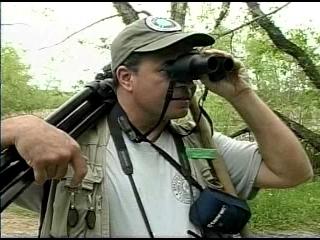
Welcome
to Brazos Bend State Park. That's me on the trail. One of the most popular
reasons for people to visit BBSP is to see the birds. Although *I* started
going to the park mainly for
the
alligators, one cannot be there for long
without learning to enjoy the birds. Thanks to visits with Doris
Mager, I met a rehab Caracara (named Cara), a few times. Ever since
then, I've
looked for, and found Crested Caracaras (Caracara plancus) near me. Over the years, I've captured a few
pictures and video clips of Caracaras, and here they are. Newest captures are at the
top.
02/27/2022. More cool encounters! So here are a couple raptors from
that morning. Crested Caracara flying over Pilant Lake at 8:55am; and a
juvenile Bald Eagle in
Pilant Lake at 9:38am, just North of the
Spillway Bridge.
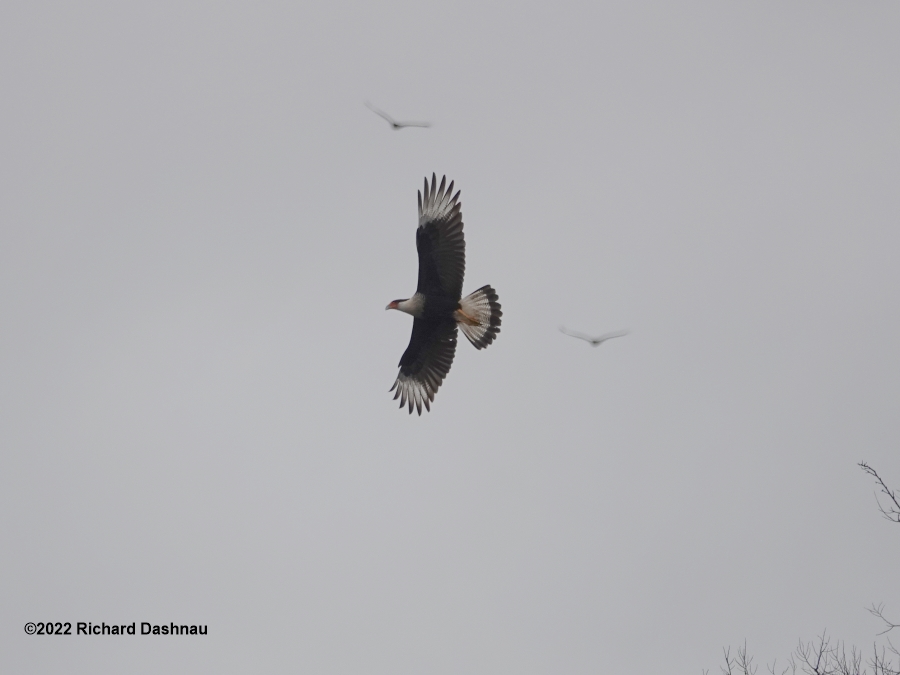
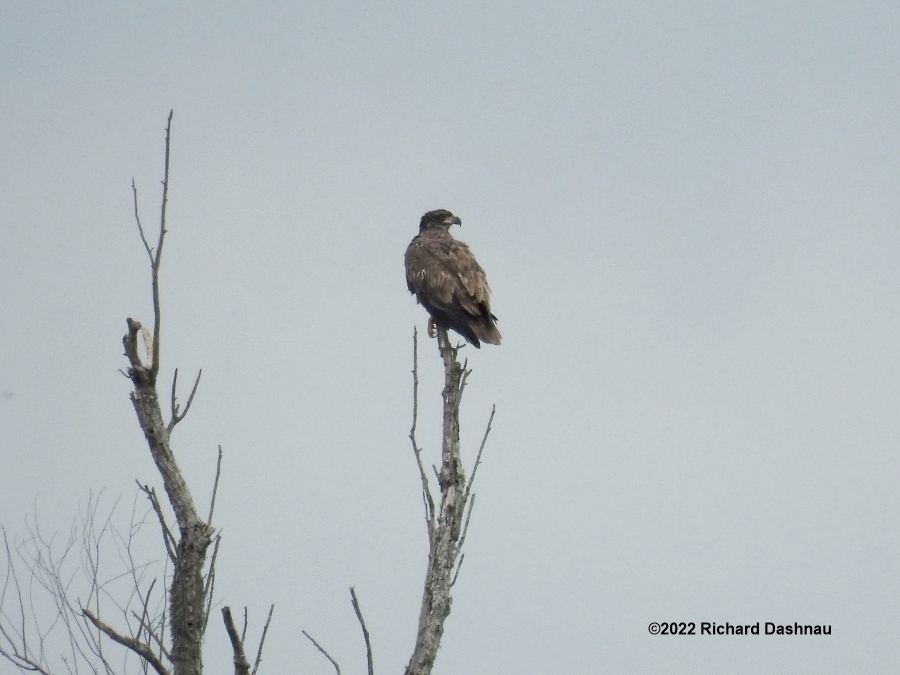
Crested Caracara 8:55am
Juvenile Bald Eagle 9:38am
At BBSP on 01/30/2022.
About 50�F Brazos
Bend State Park when I got there. Instead of watching over Pilant Lake,
I decided to head down the Spillway Trail
to
Otter Island (about 800 steps East of the Tower) to look for Otters.
No luck on this day, but Crested Caracaras
(Caracara plancus) were visible through the day, while I stayed around
the
mother alligator and her den. They've been active in the area for
weeks (I've got other images here already), and seem to be a mating
pair. (There must be a nest somewhere near--or will be.)
I caught a
single frame of one of the Caracaras carrying something long and
dark--possibly a siren carcass. Click on the link to see a video of the two Caracaras eating a mystery carcass.
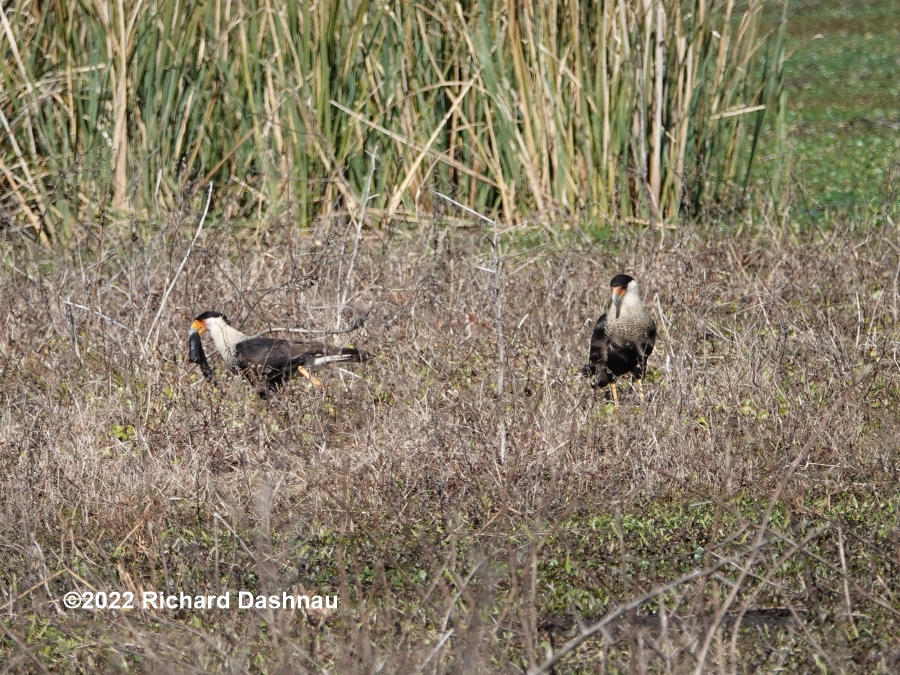
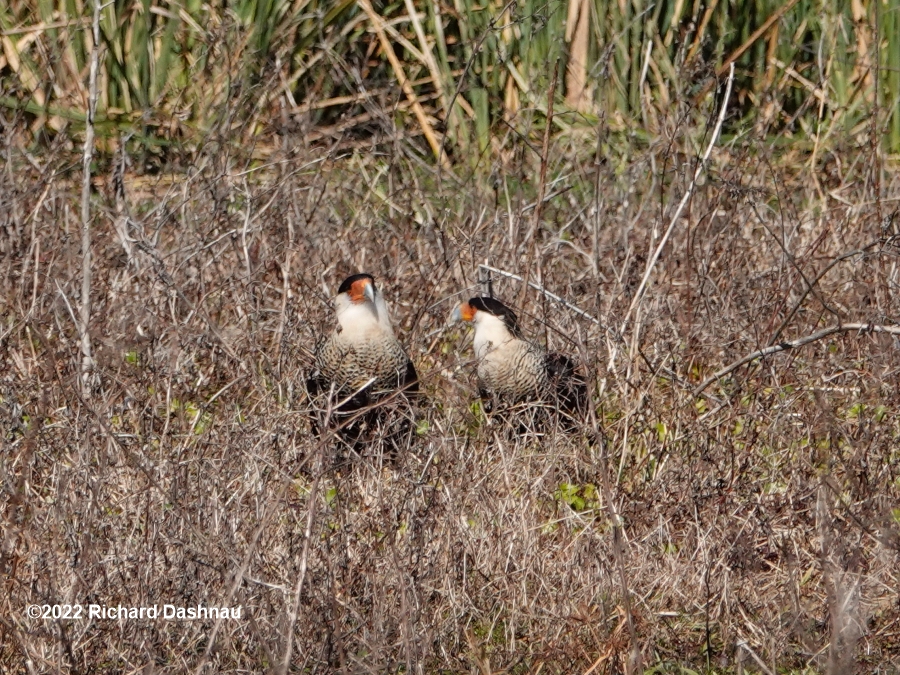
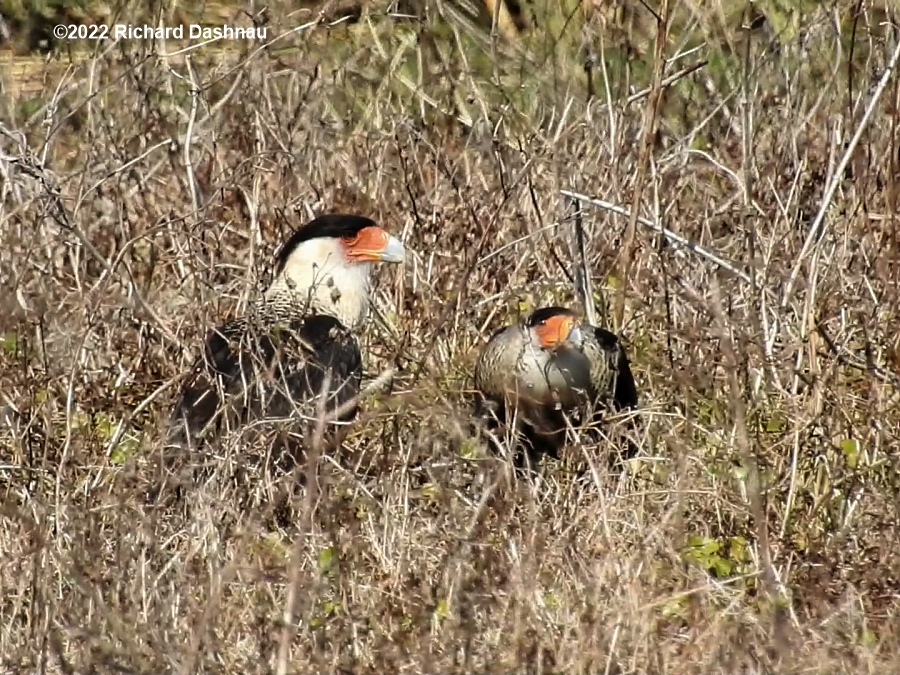
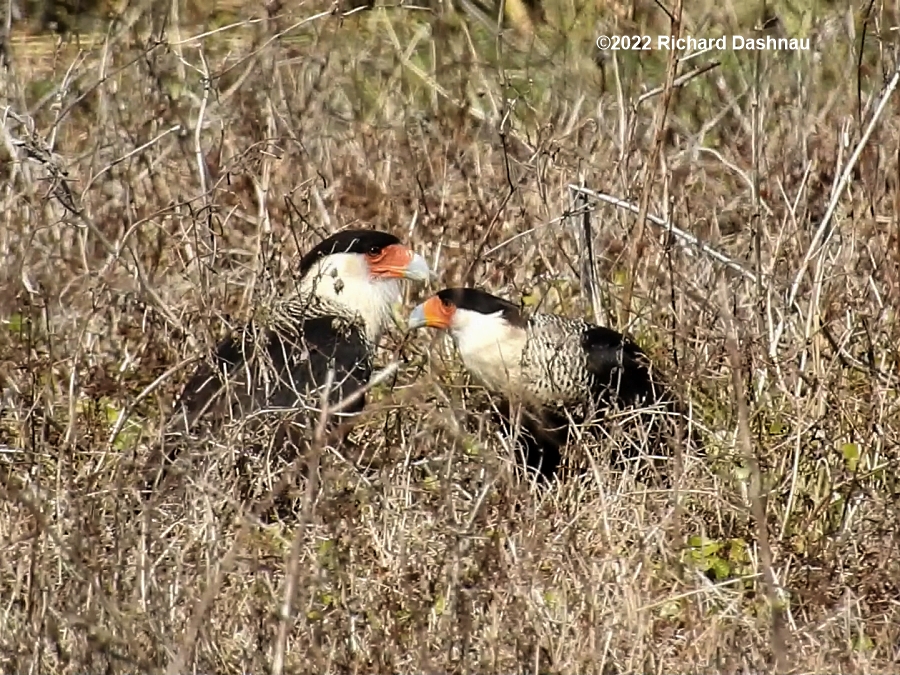
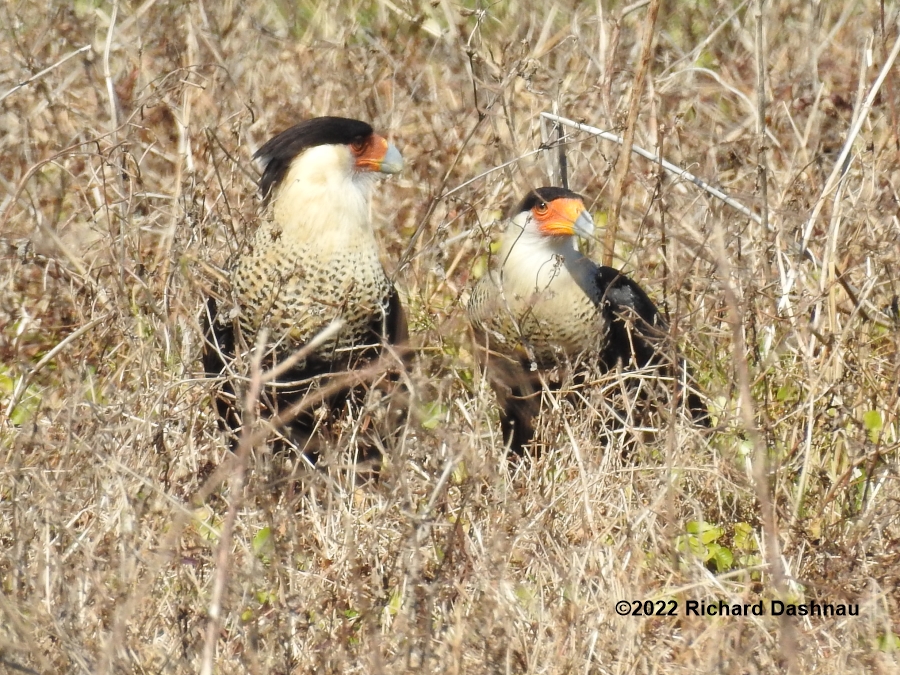
01/09/2022.
Caracaras at Brazos Bend State Park. A pair of Caracaras were in Pilant
Lake, about 100 yards North of the 40-Acre Lake trail. Although they
were
so far away, I started shooting video anyway. Even though it was only for about 15 minutes, I caught
some interesting behavior. They were at a carcass, and I watched
them share
a few beakfuls of food, talk with each other, and even mate. Then they flew off. I've edited the video clips I captured into this 5 minute
video. The images below are all frame grabs
from
the video clips. Unfortunately, since the Caracaras were so far
way, I had to crop and manipulate the video so it would be clear. This
didn't help much with the single images.
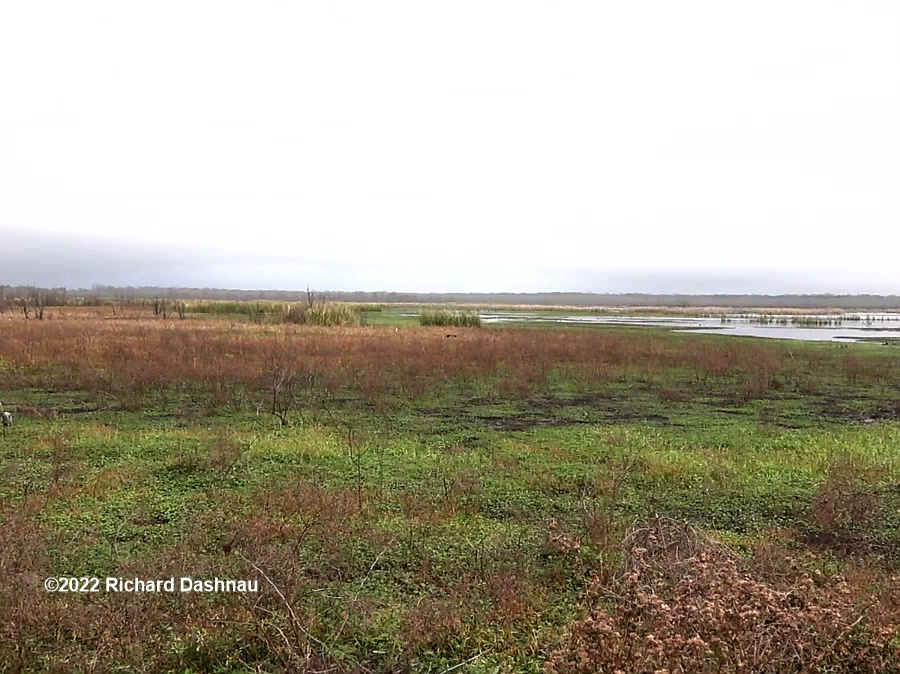
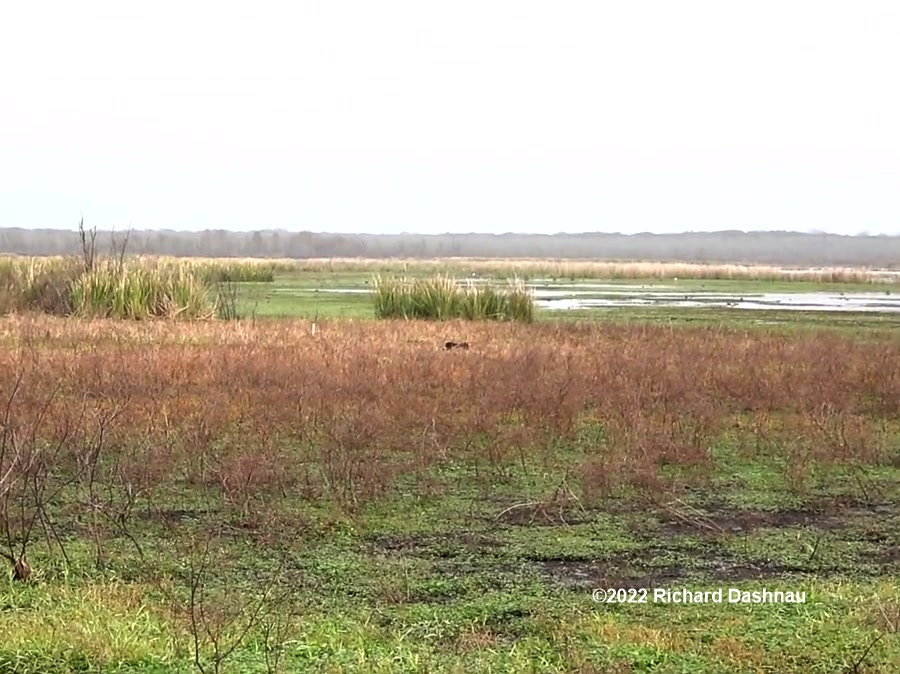
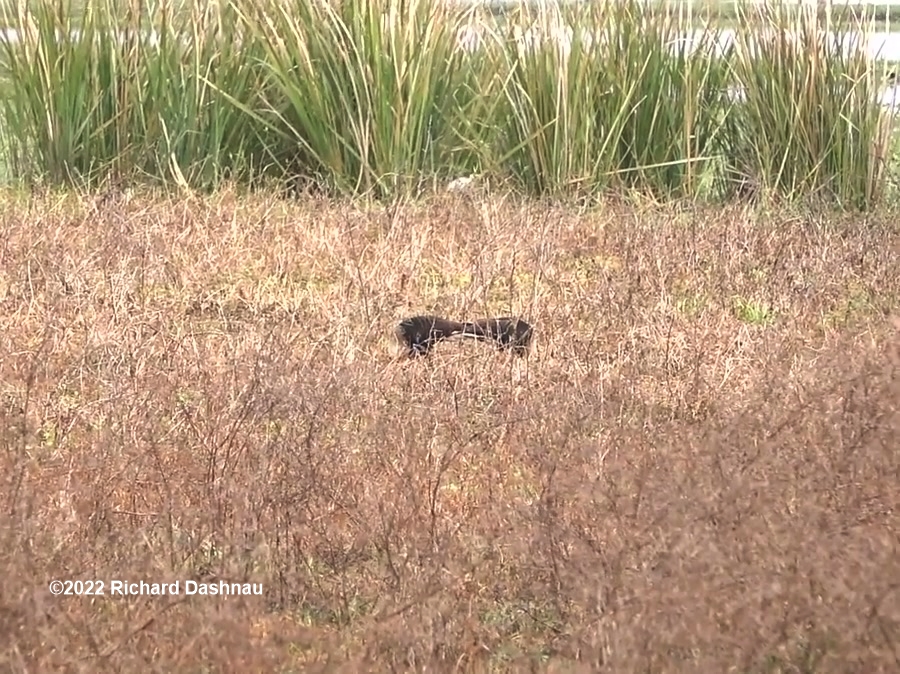
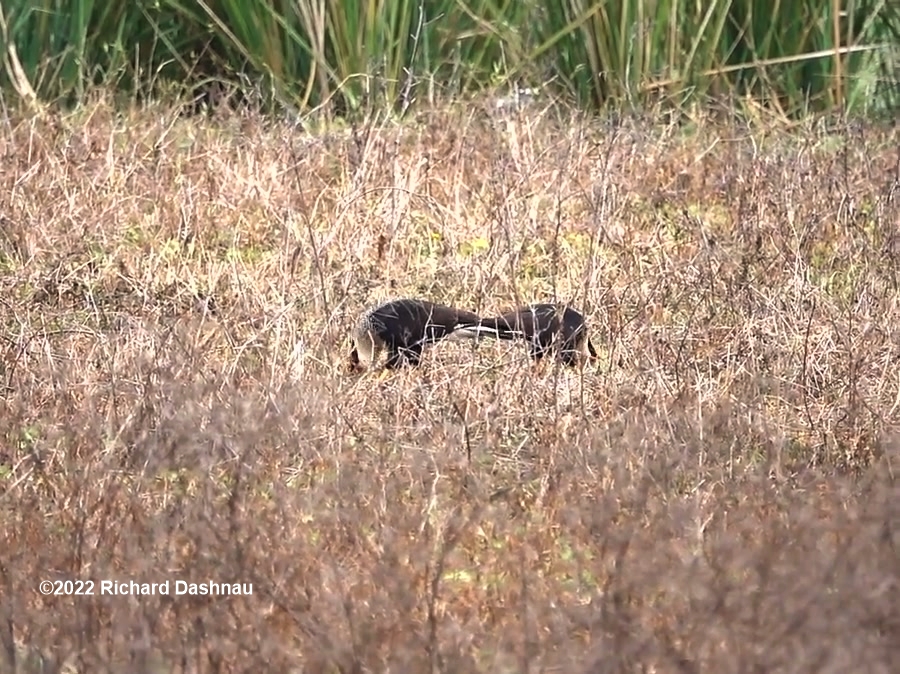
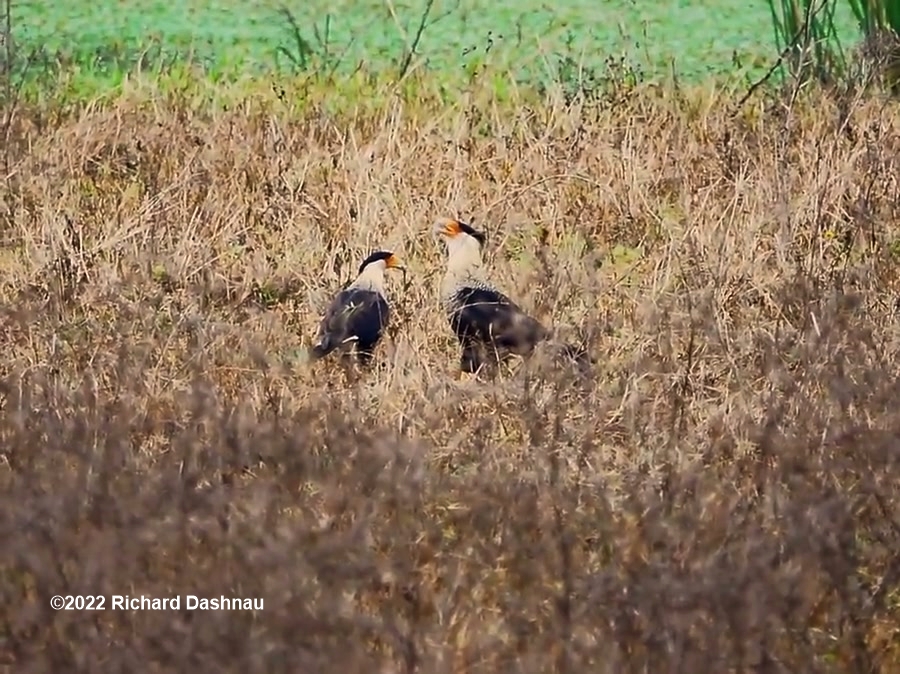
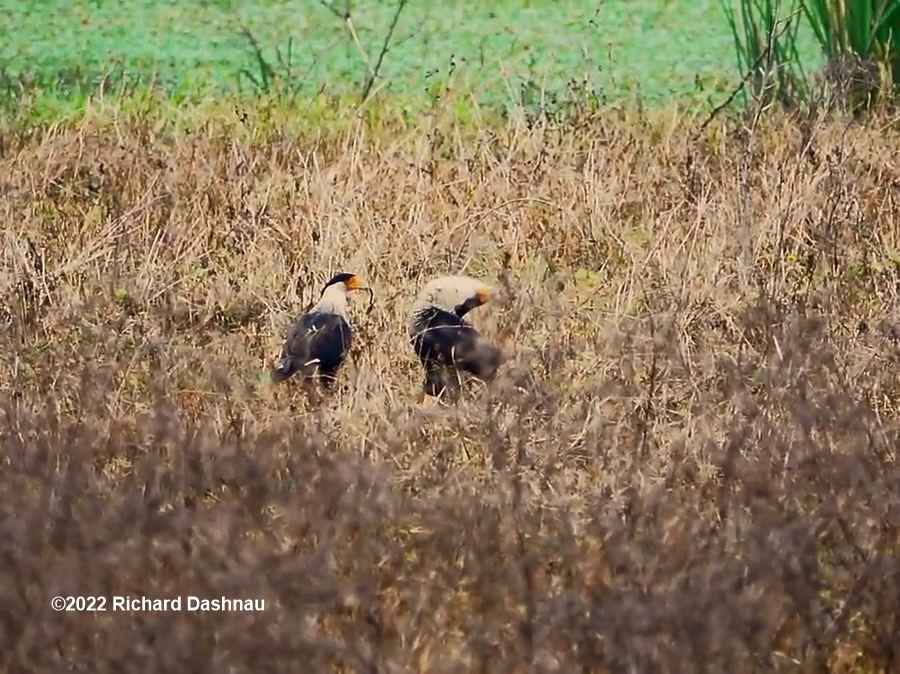
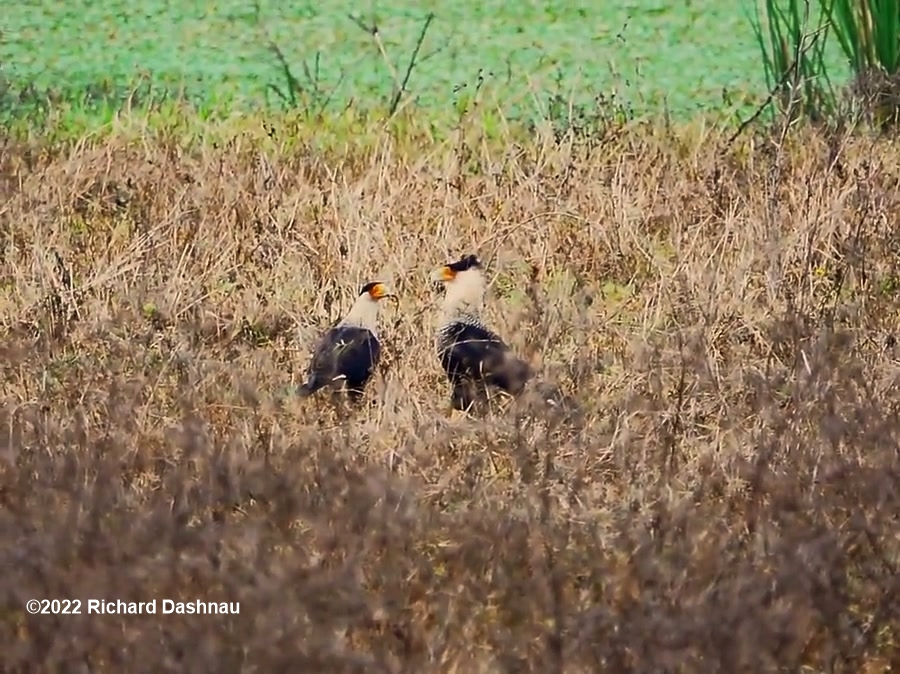
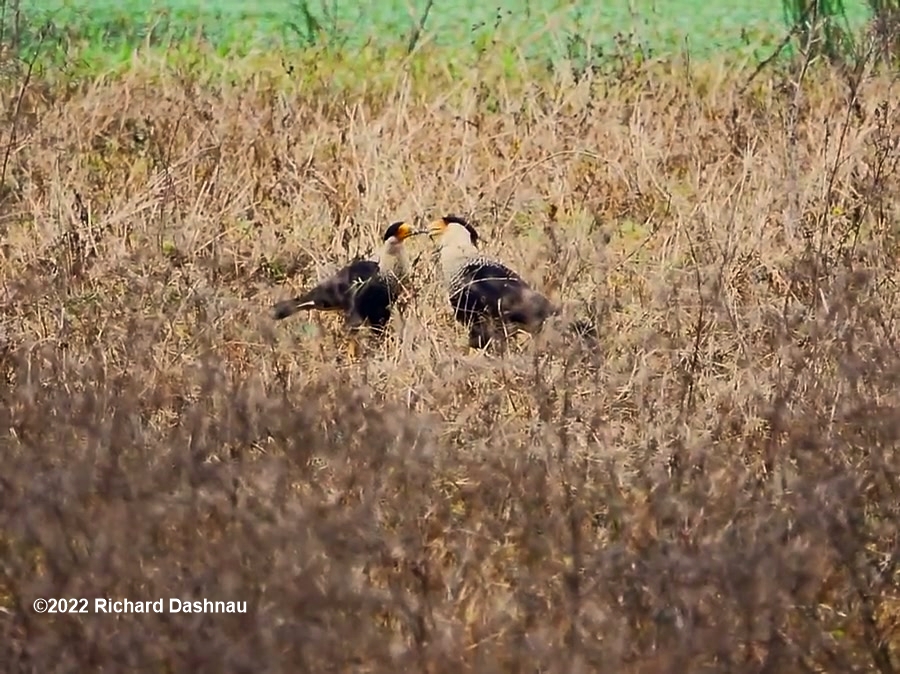
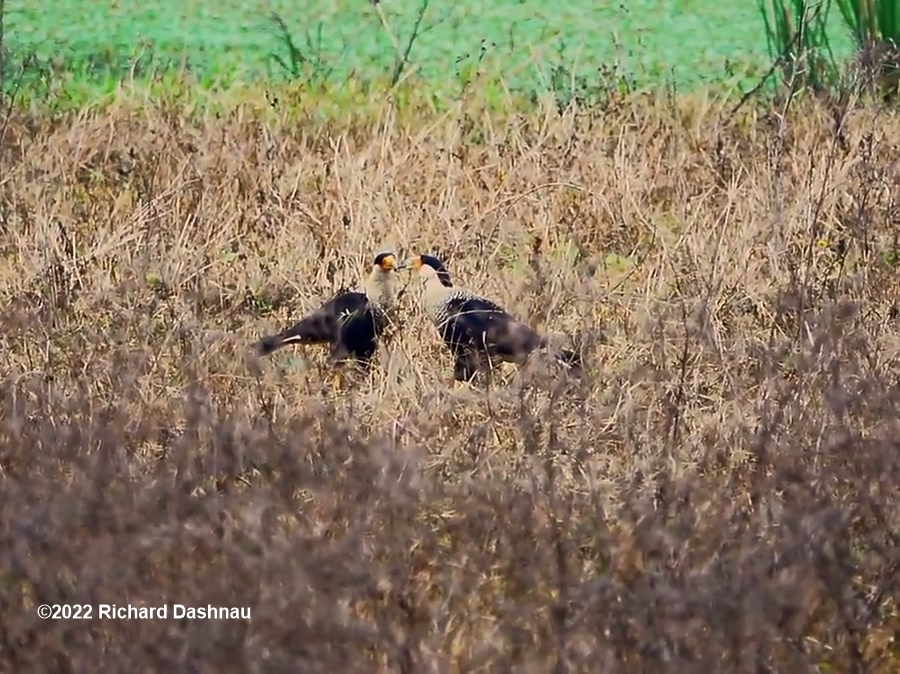
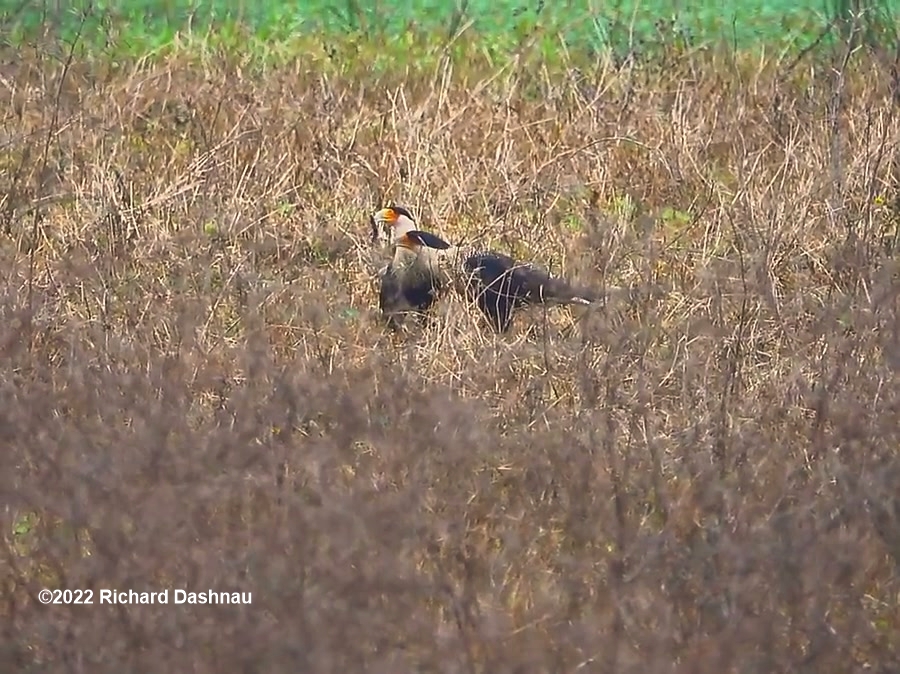
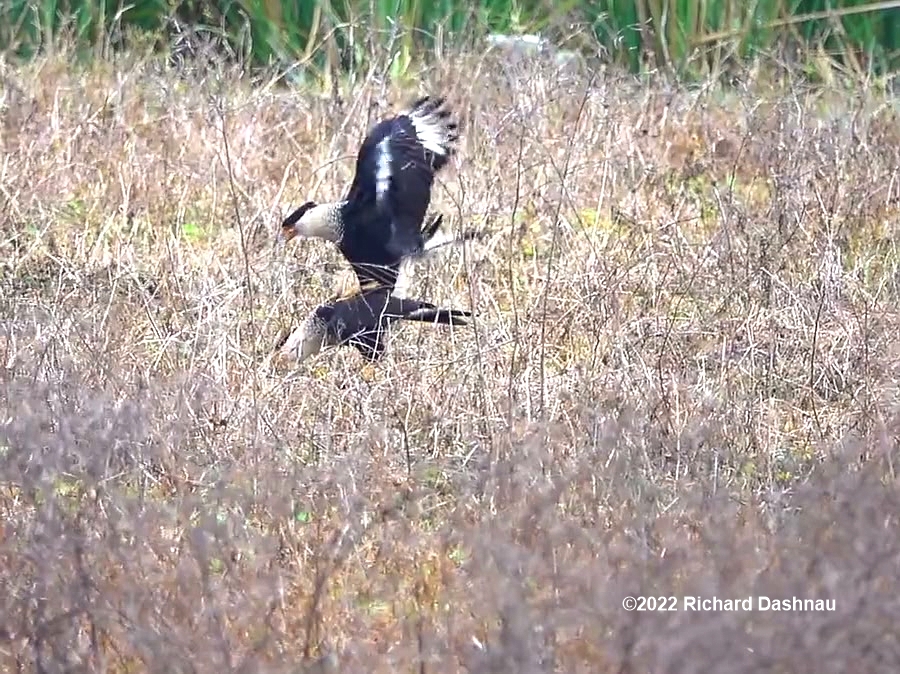
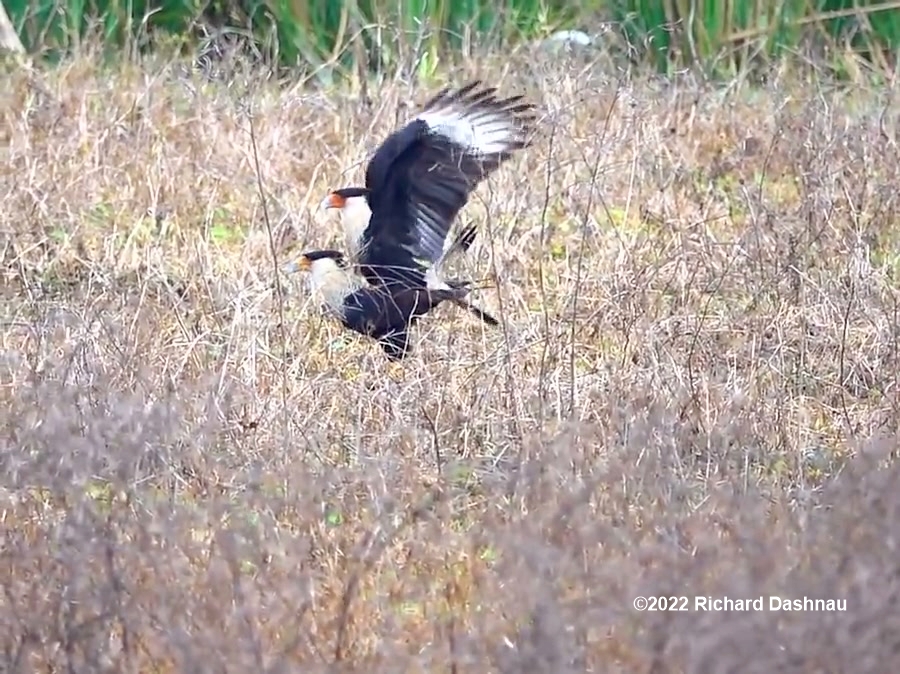
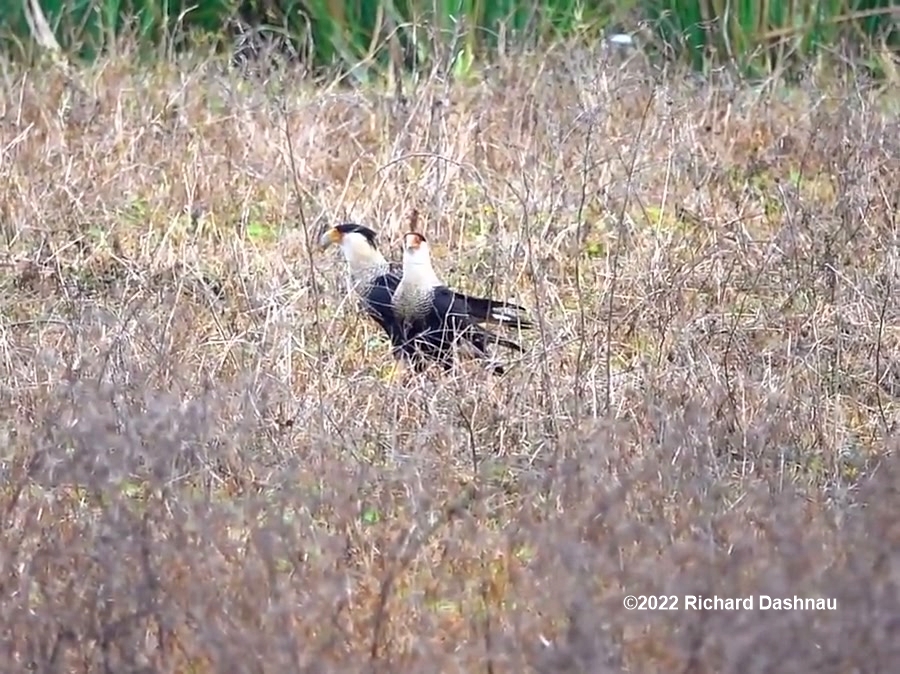
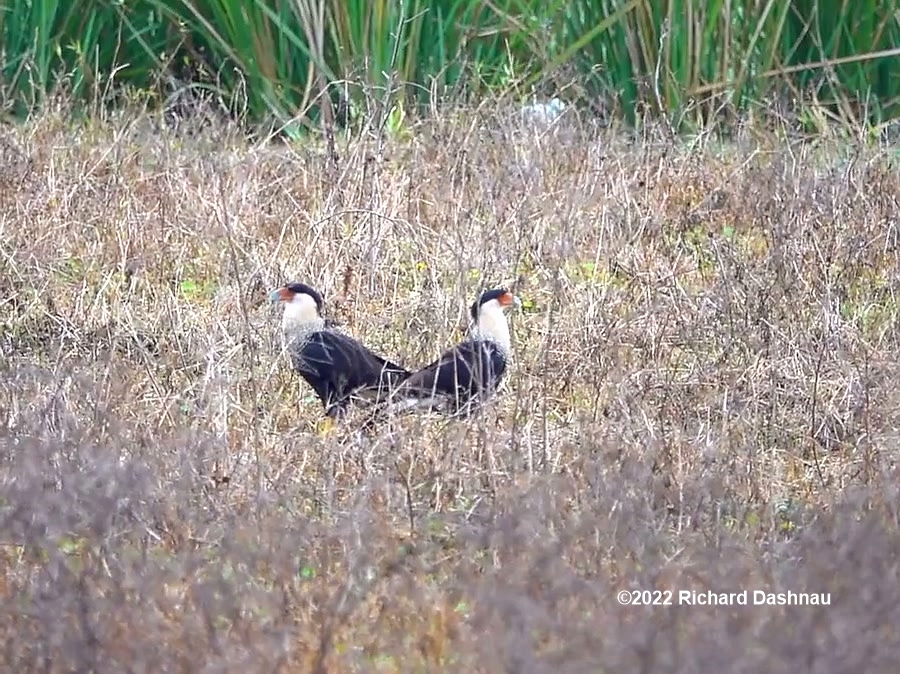
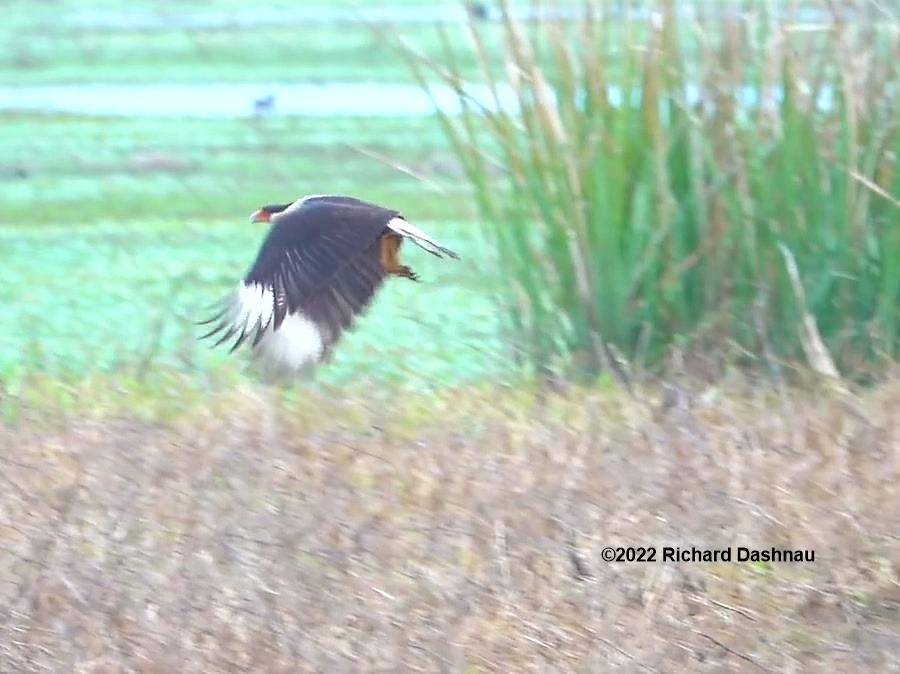
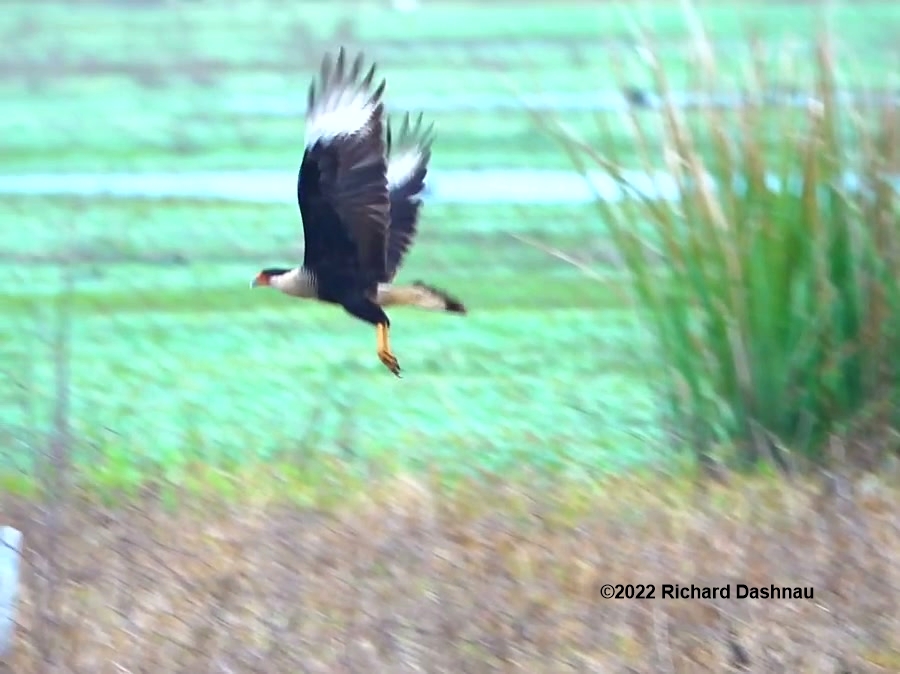
On 01/01/2022;
I was one of the guides during the First Day Hike at Brazos Bend State
Park. The weather was unseasonably warm, to say the least (near
80�
F later in the day. The "hike" portion of the day was from
8:00am
to 12:00 pm. I'm often on the trails doing "roving interpretation"
anyway, so my part wasn't much different.
There were just more
people hiking around 40 Acre lake than usual. Since the
weather
was so warm, it was very comfortable in the morning. A few alligators
were moving around,
a pod of baby alligators was visible (I've been
monitoring them for weeks, so didn't take any pictures for this hike).
It was a lot of fun! Here are a few pictures of the
less-common
sights.
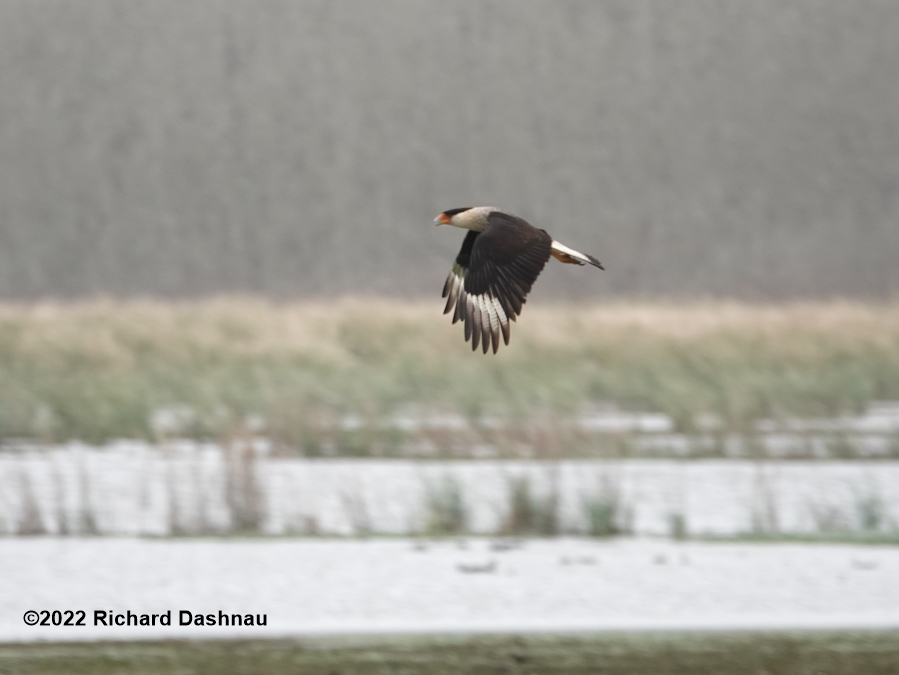
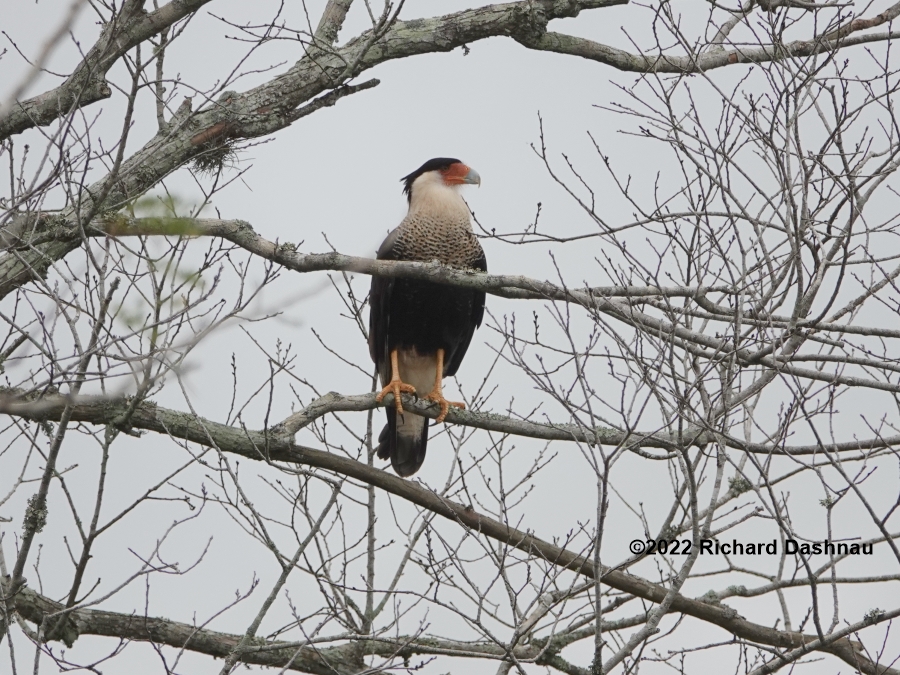
Crested
Caracaras (Caracara plancus) have been active in the area (North side
of 40 Acre Lake) more than usual over the last month or so--at least as
far as my experience. I saw
them quite a few times during
First Day Hike.
On 11/07/2021;
I parked in the 40-Acre Lake parking lot. I opened the car door,
looked out, and saw this Red-Shouldered Hawk (Buteo lineatus) perched on the
sign about 20 yards away.
About
30 minutes after leaving the hawk, a Crested Caracara (Caracara plancus) flew in from the
North, and landed in a tree on the 40-Acre Lake Trail. 5
minutes later, it took off and flew
North. While I
was looking that
way, I noticed another Red-Shouldered Hawk (Buteo lineatus) (I.D. provided by Lauren Helton (twitter: @tinylongwing) thanks!) perched at the top of a small,
bare
tree. The images below are taken from photos and video clips I shot at
the time. I've also edited a 7 minute video clip
that collects the video I captured of these events. The wonderful
yellow flowers are probably Swamp Sunflowers (Helianthus agustifolius).
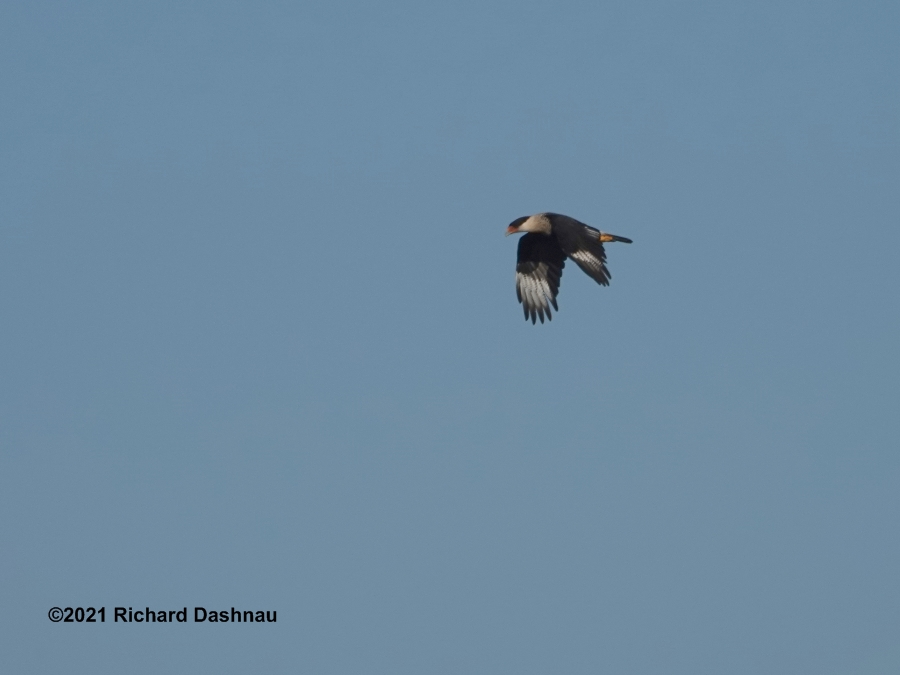
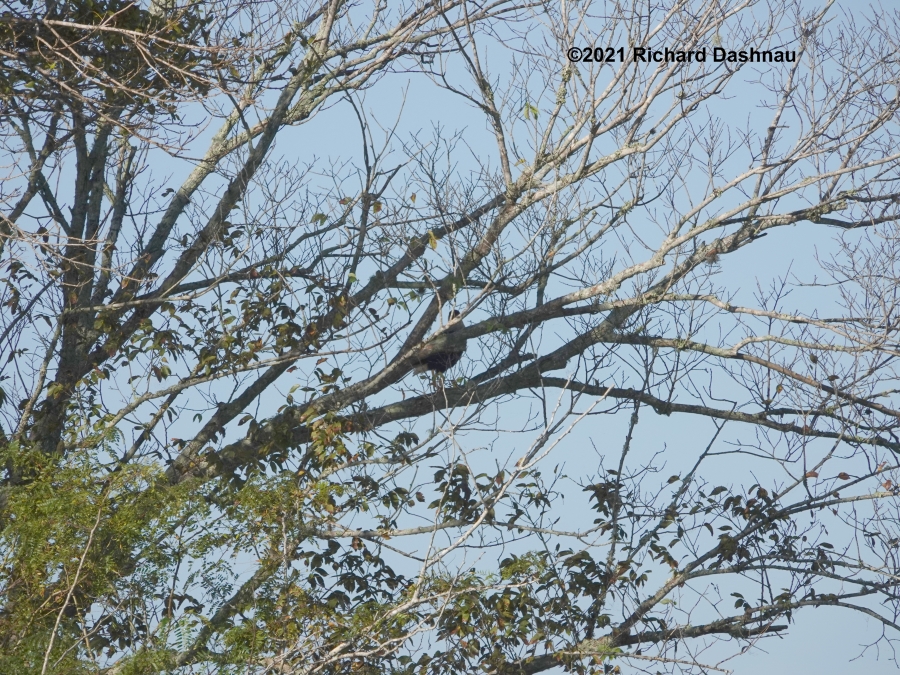
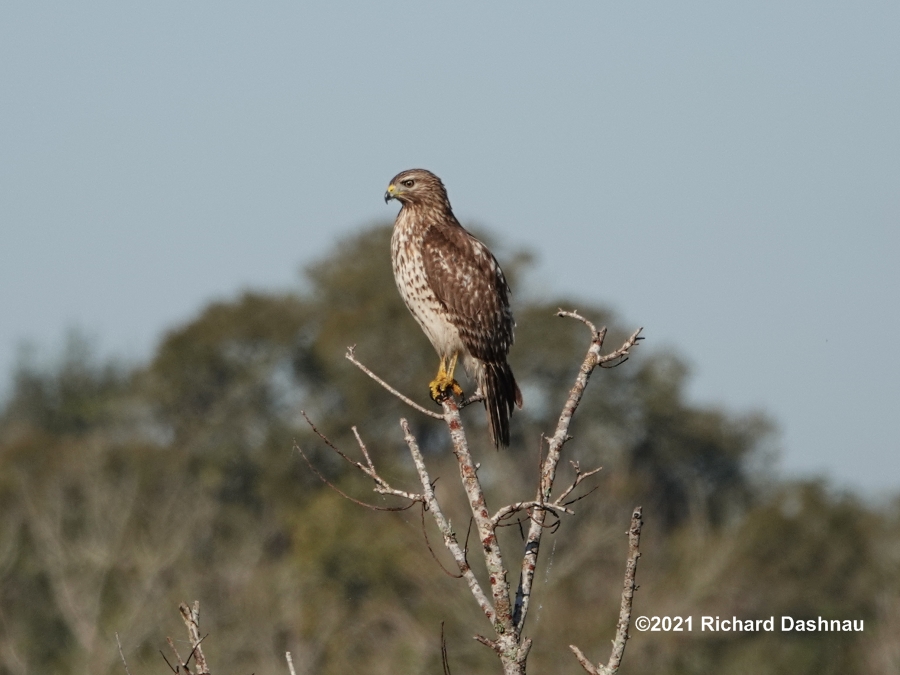
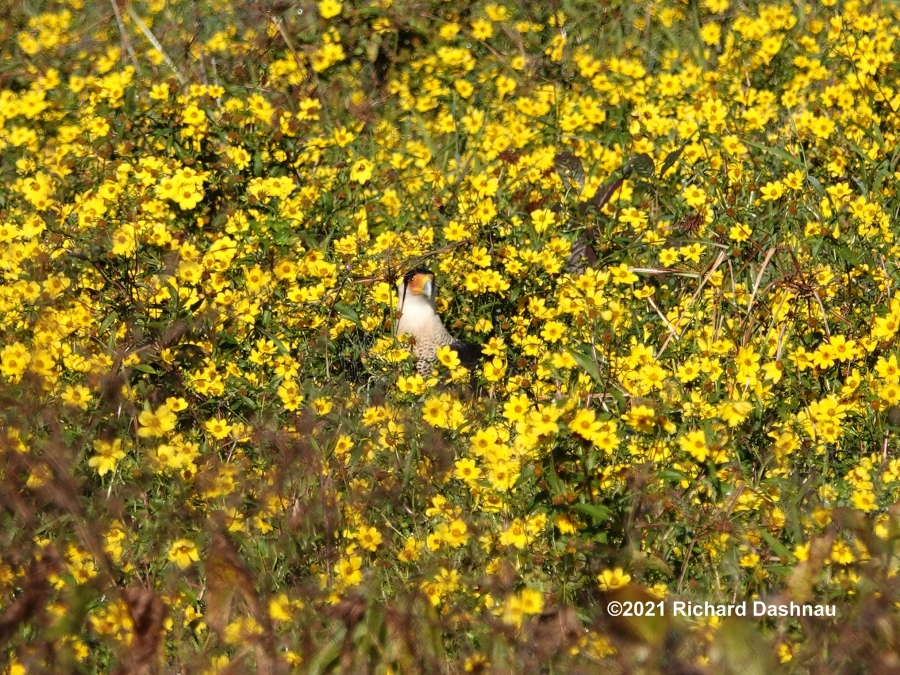
The
Caracara returned from the North, so I started shooting video.
While I filmed, the Caracara got closer and closer! Then it turned
while it was overhead, circled back out, turned again.
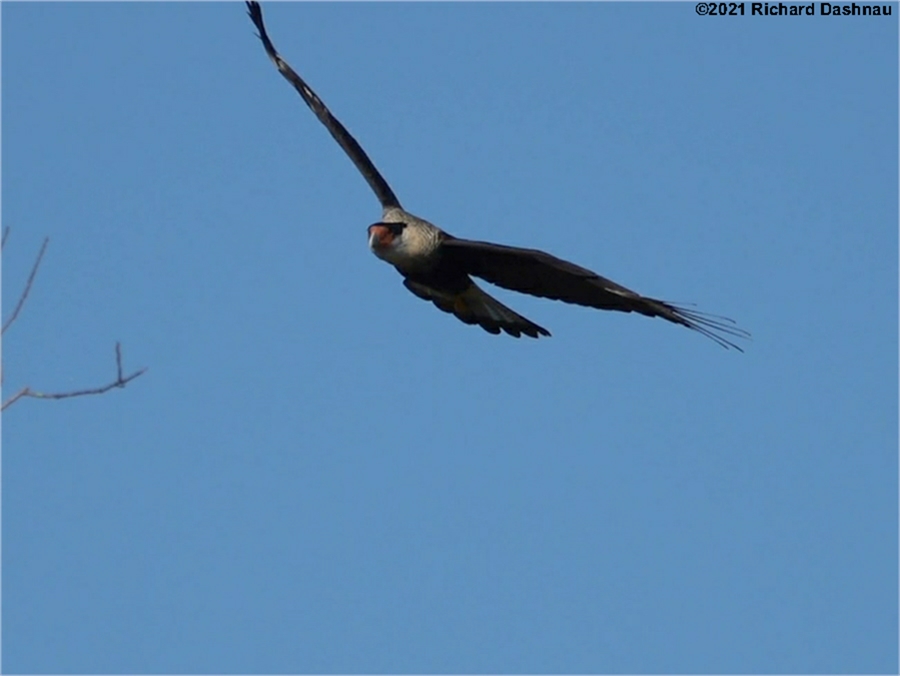
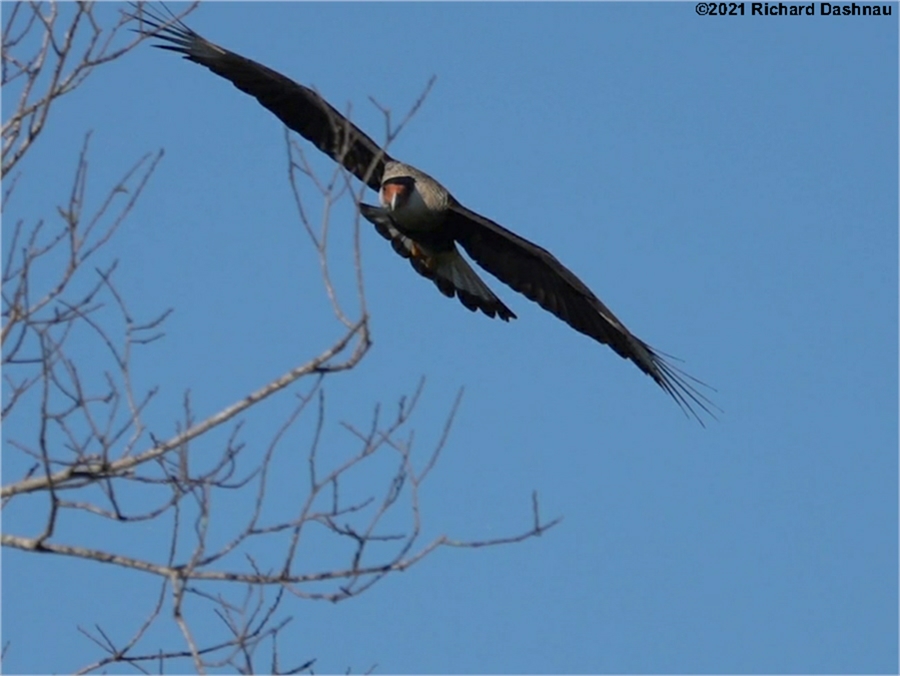
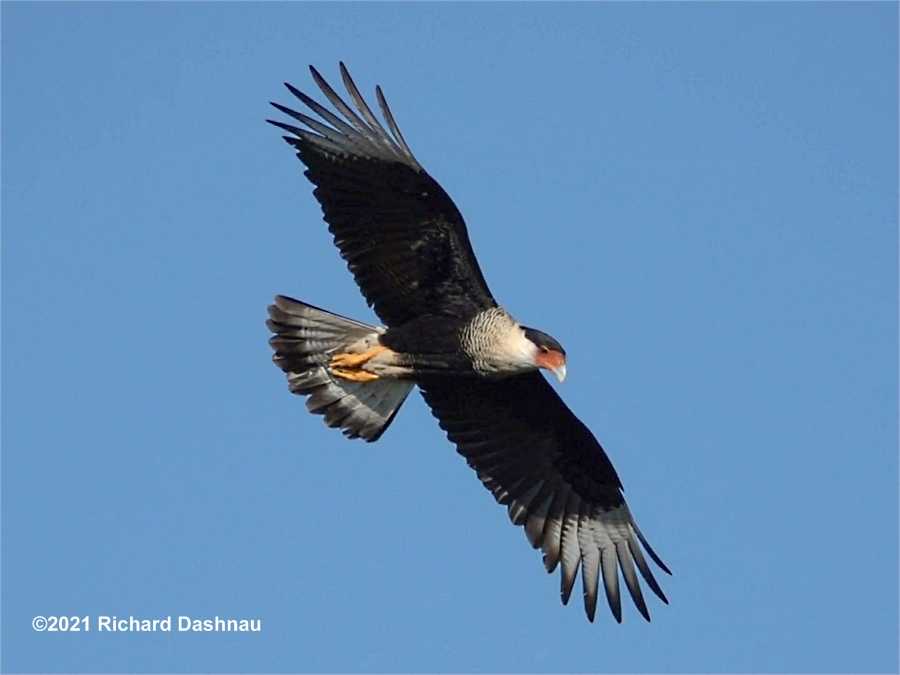
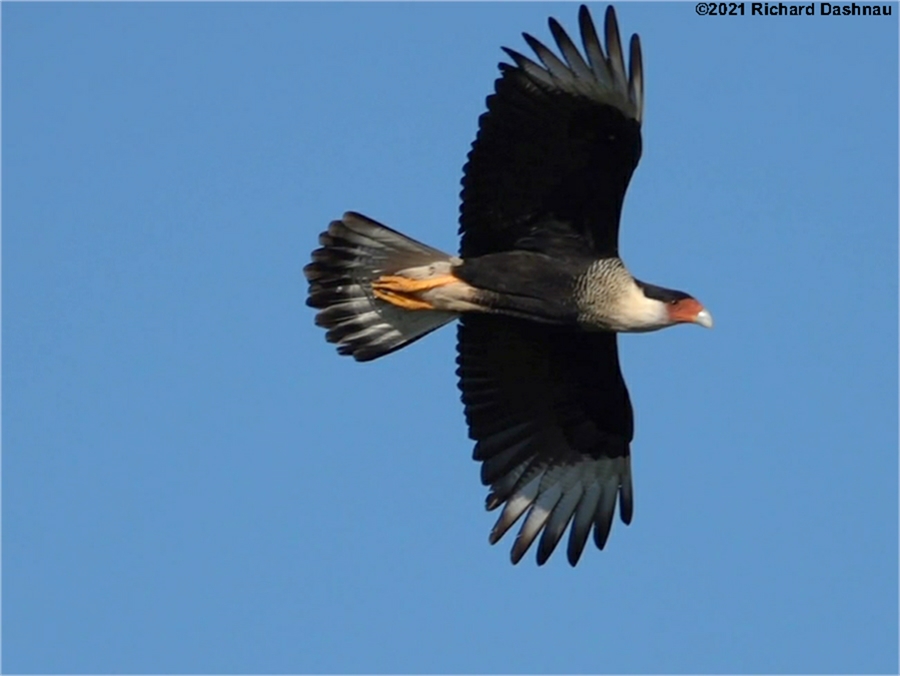
Then it
swerved and flew right at the hawk! It didn't hit the hawk, but passed
so close that it could have. Then I noticed that another Caracara was
standing among the Swamp Sunflowers.
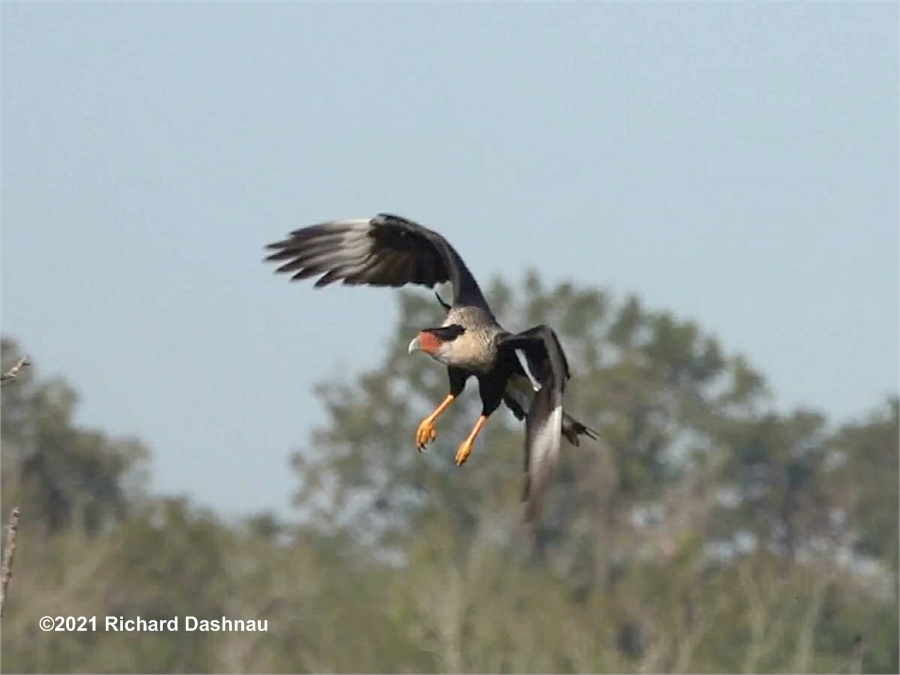
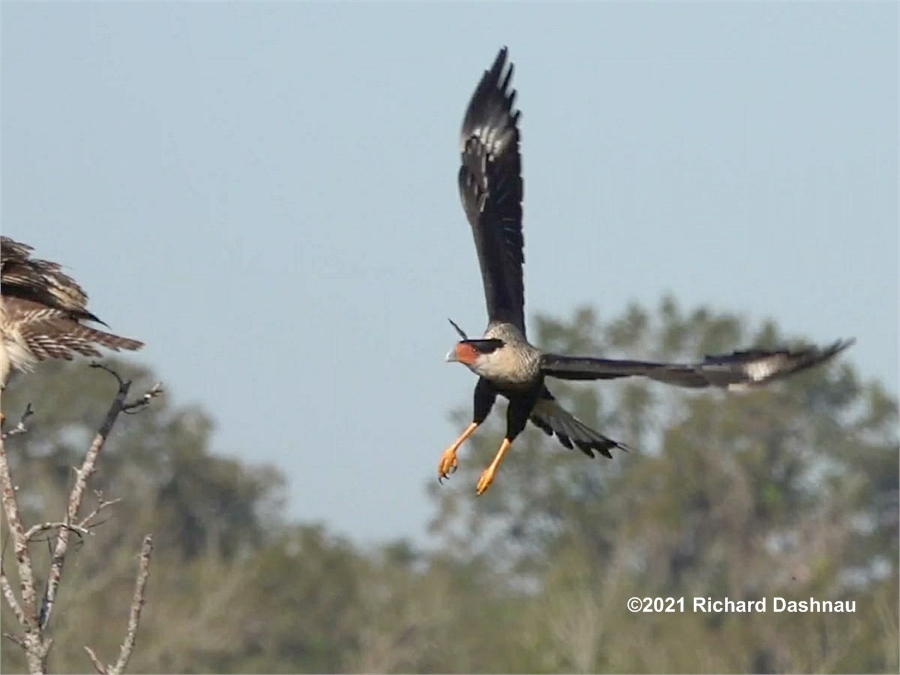
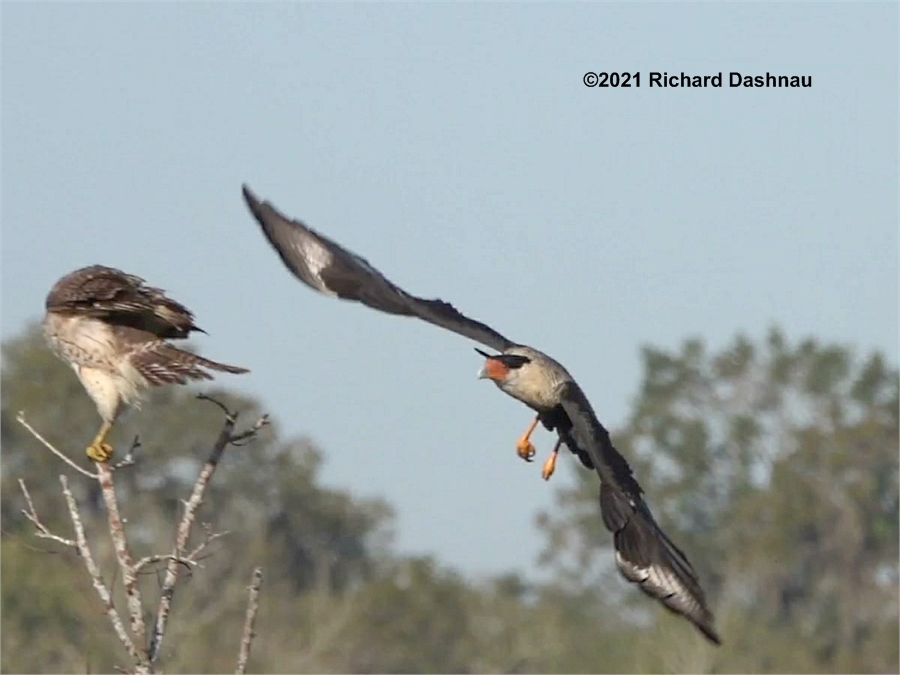
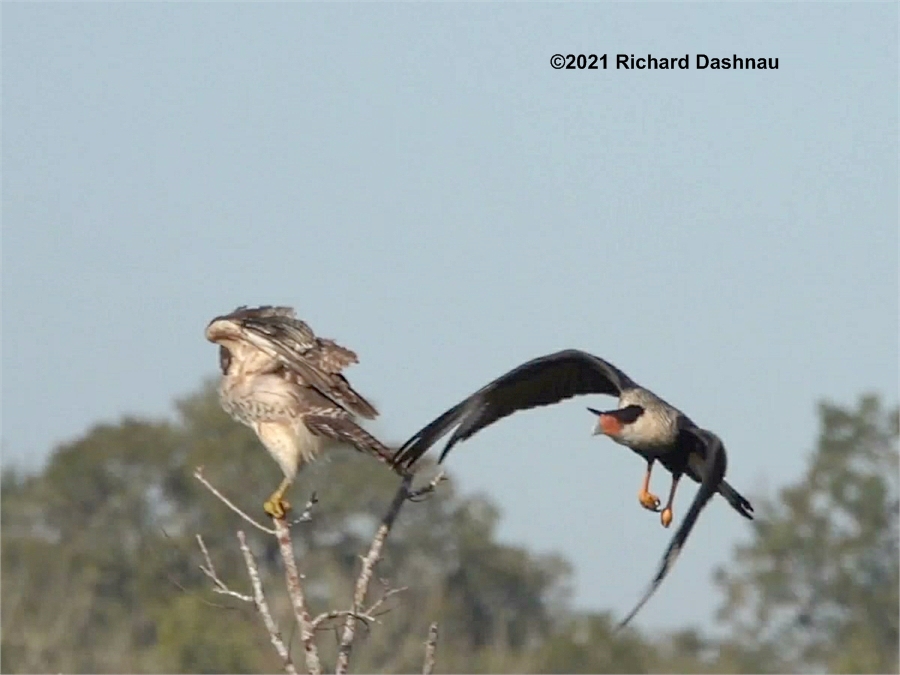
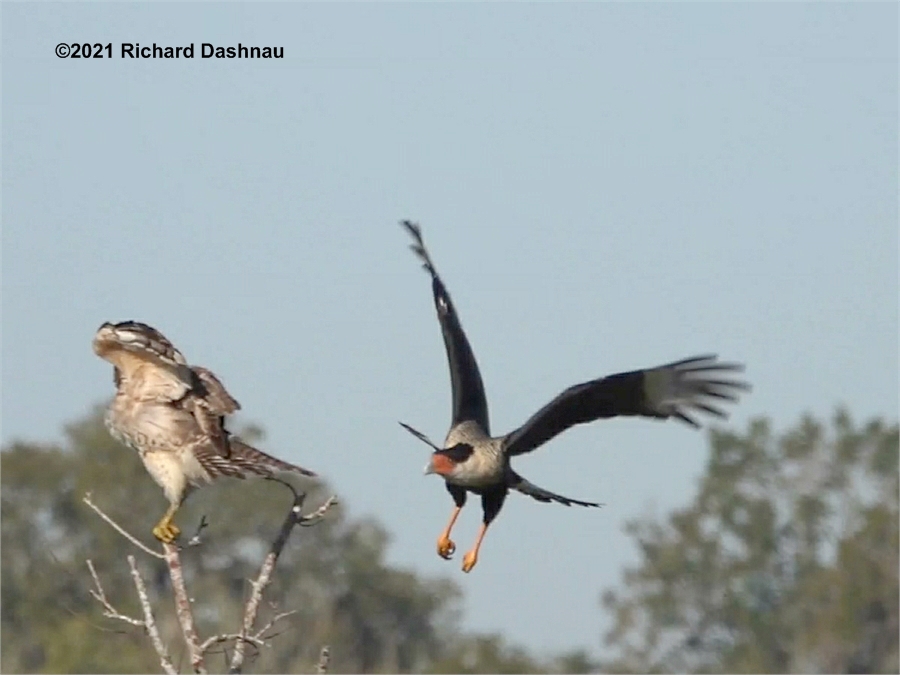
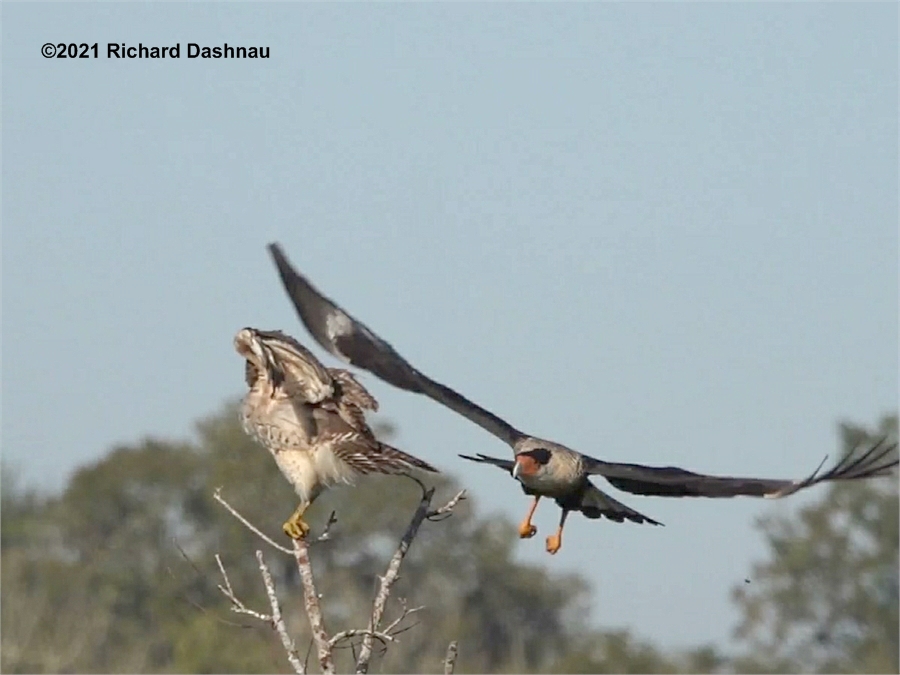
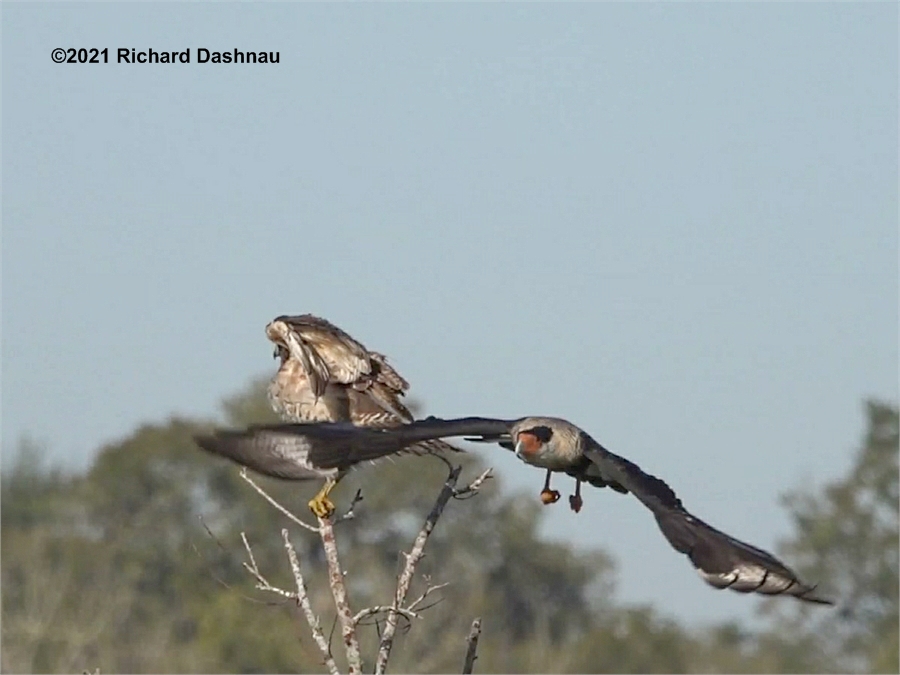
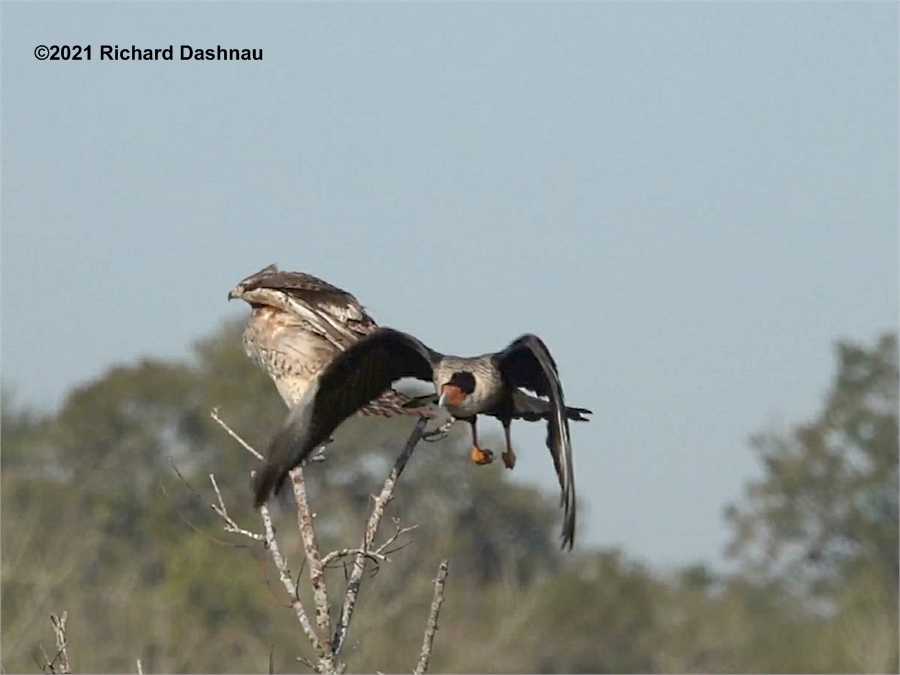
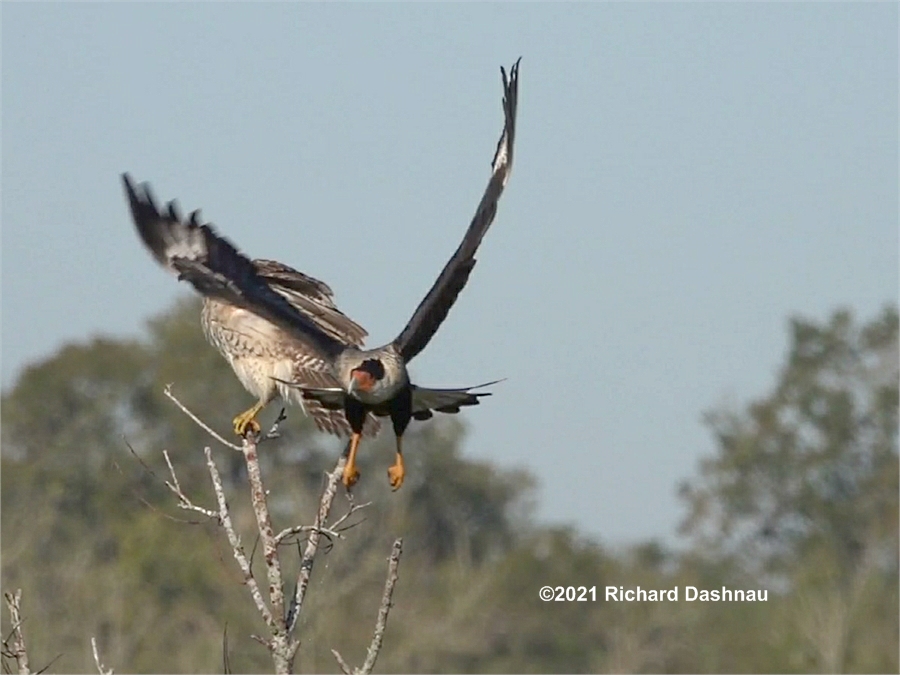
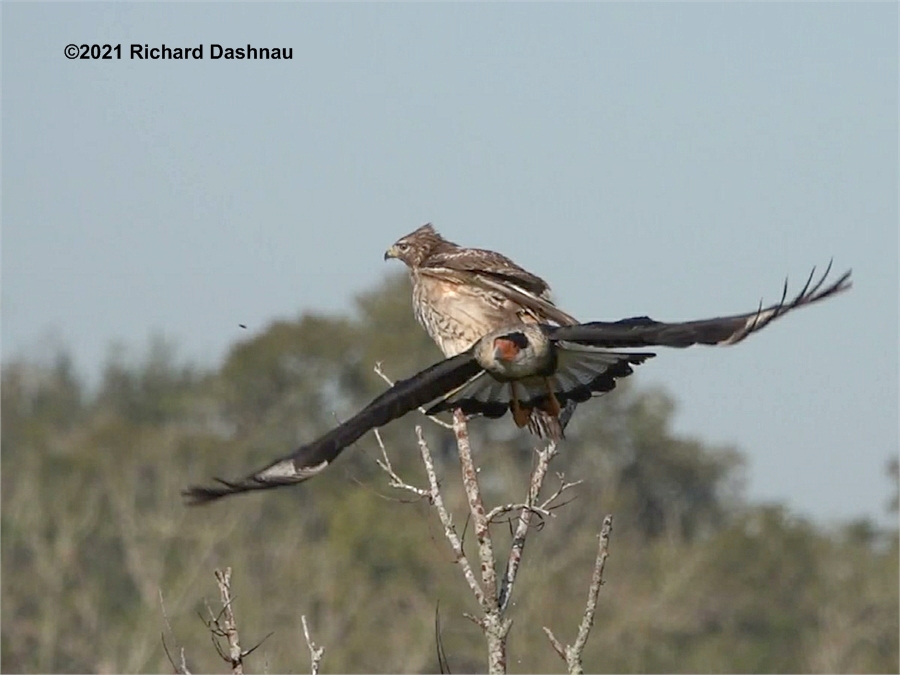
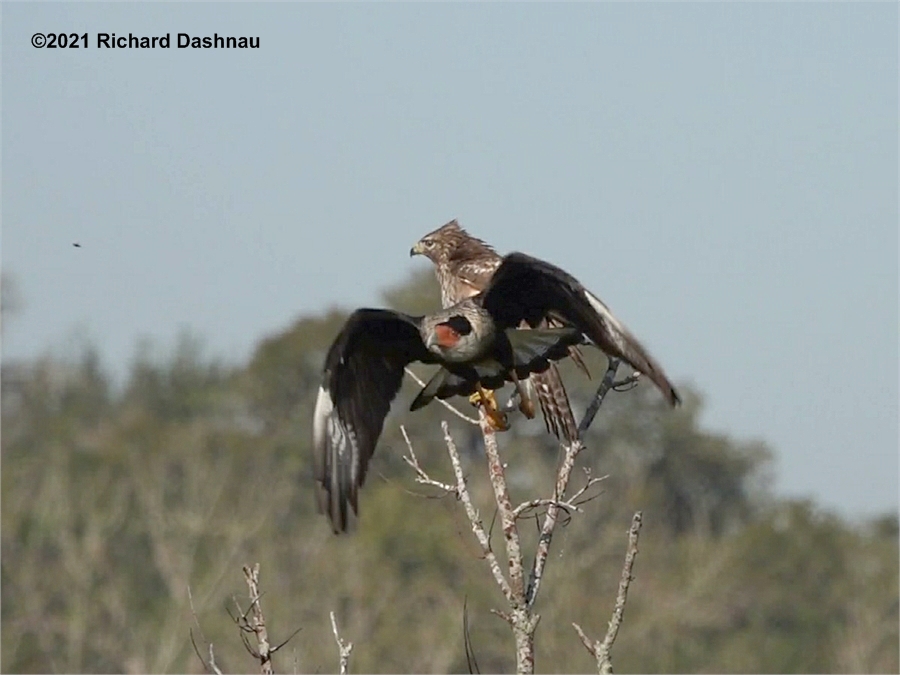
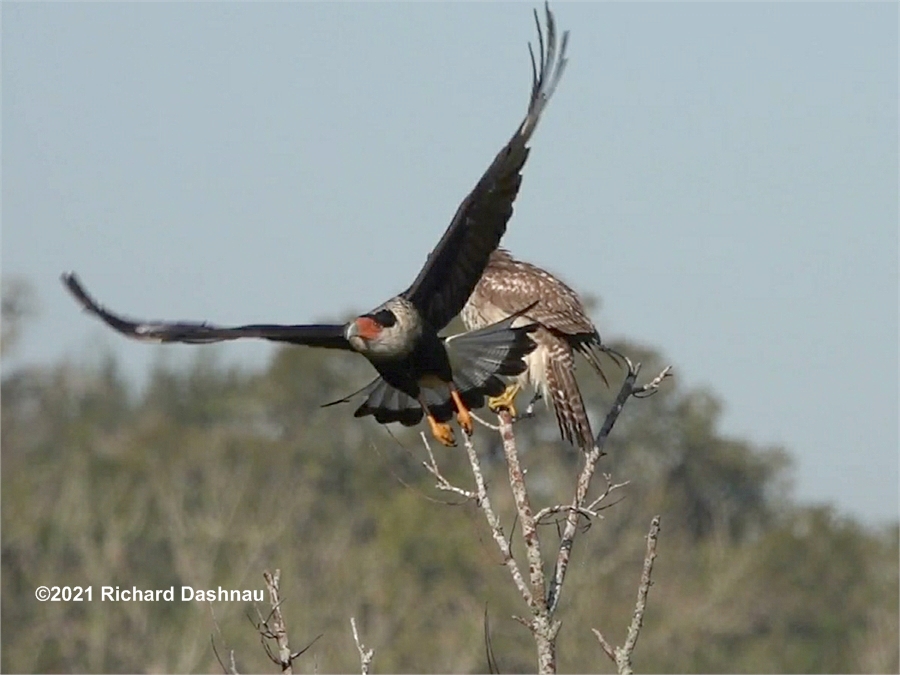
When I focused the camera on
the one on the ground, the Hawk buzzed that Caracara, then landed among the flowers a
yard or so behind the Caracara.
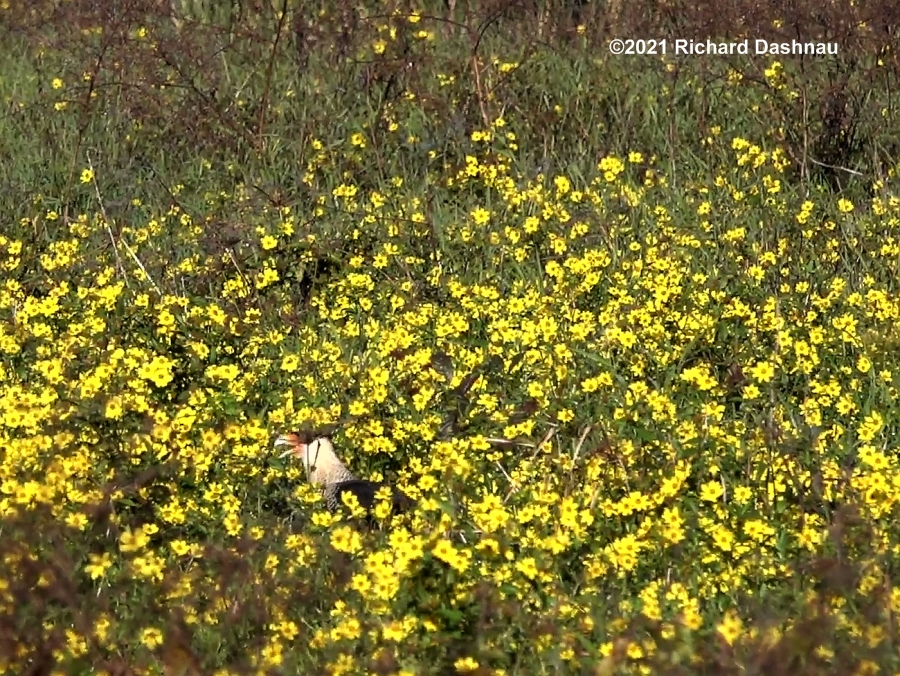
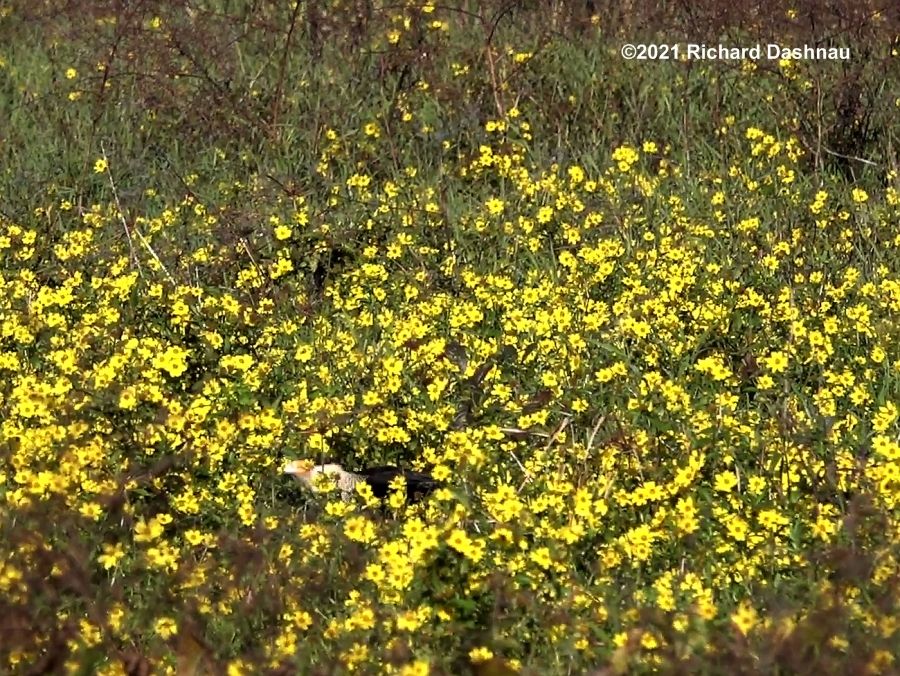
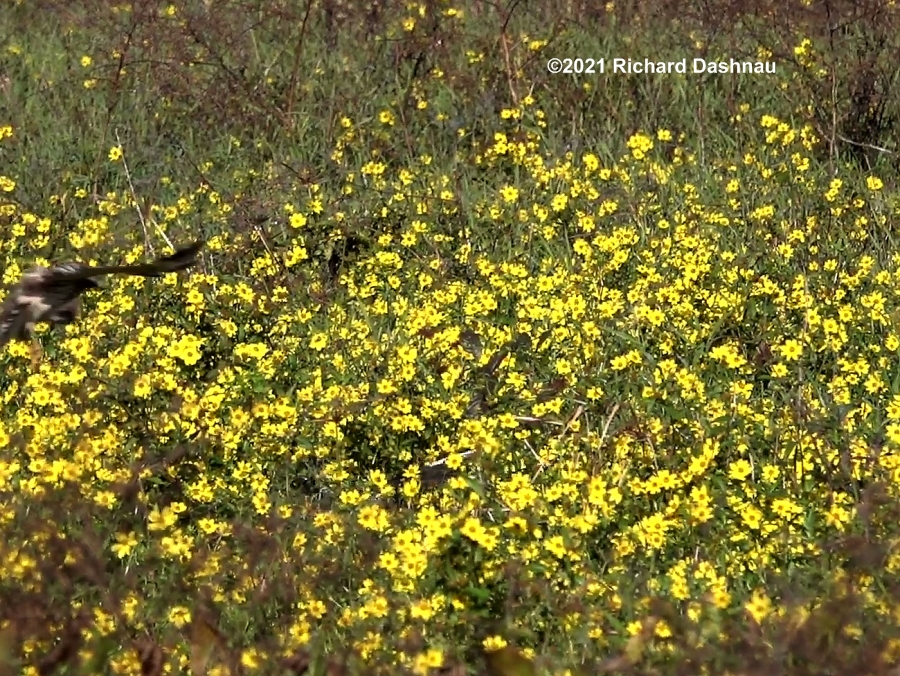
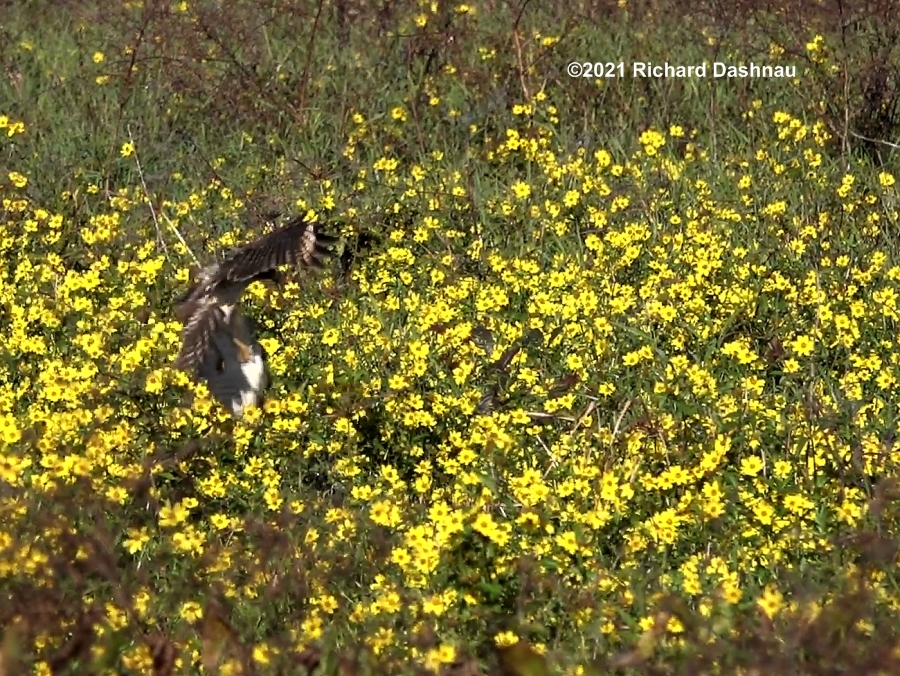
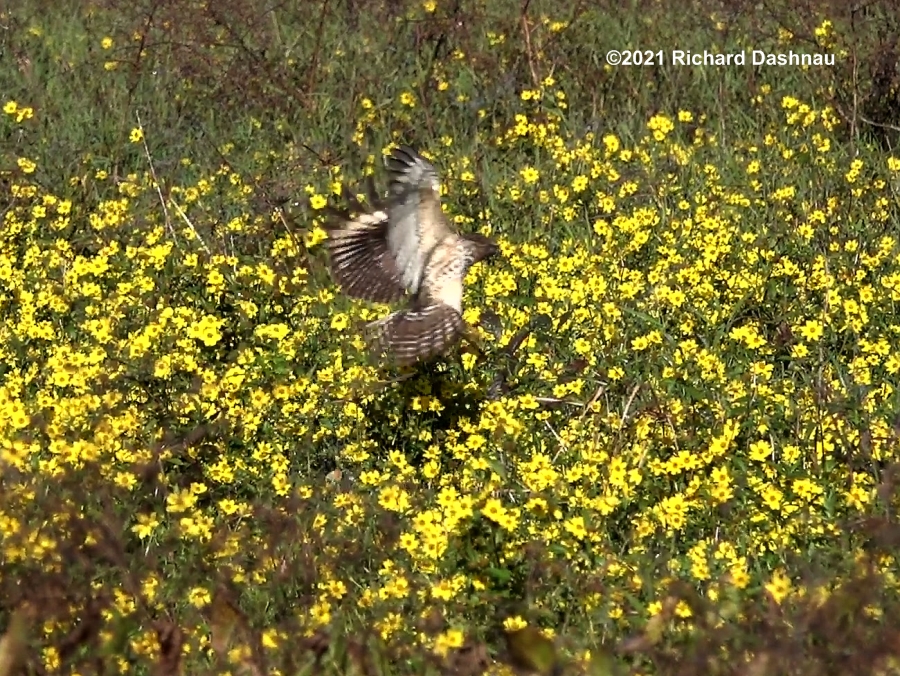
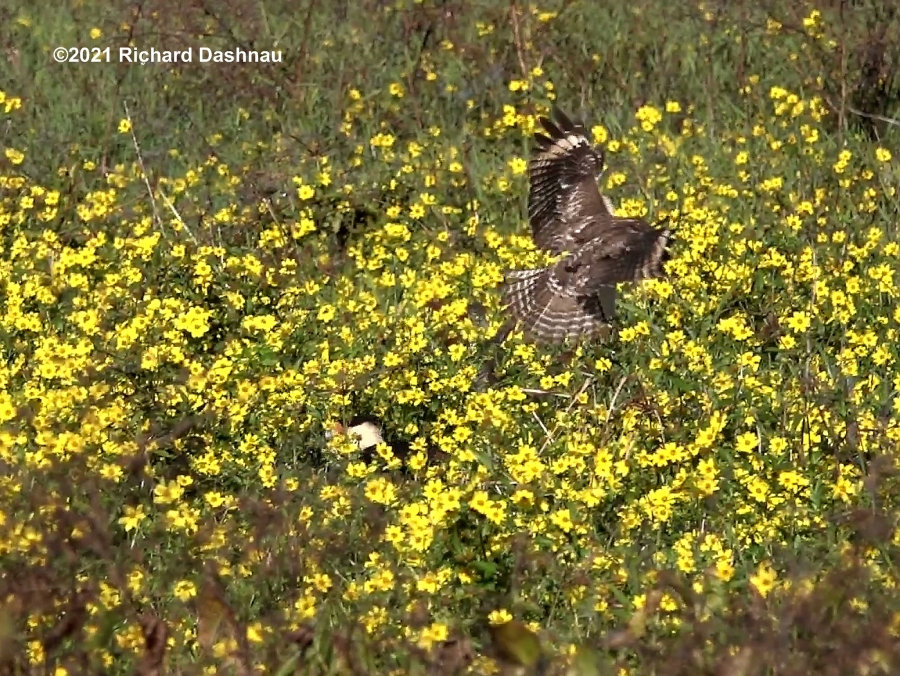
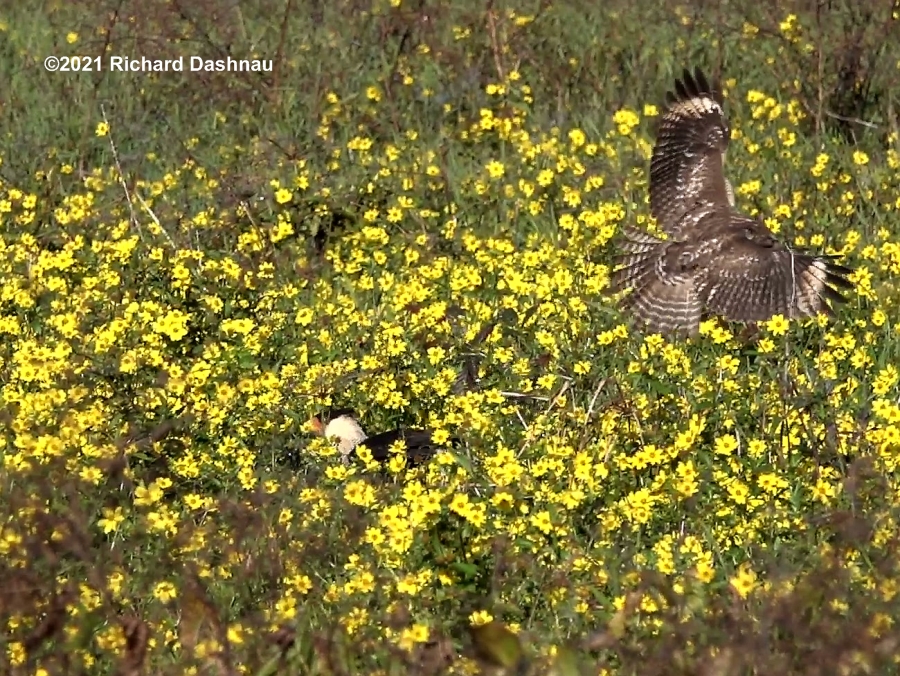
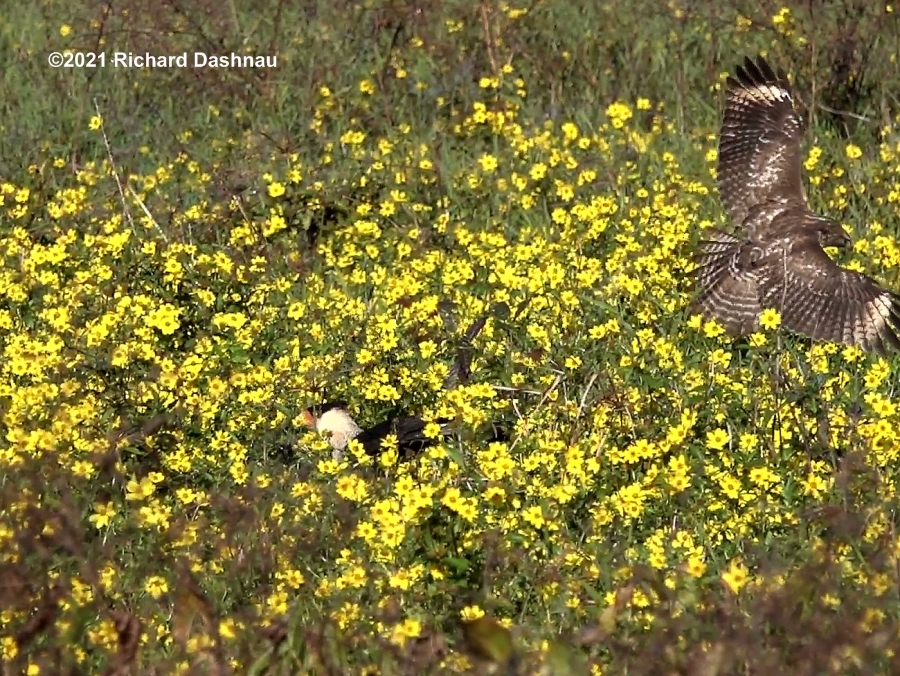
The Caracara-which had ducked to avoid
the hawk-stood up with its back to the hawk, then bent its head
backwards to look at the hawk. I've only witnessed a captive
Caracara do this, but
have read about the behavior. They sometimes "laugh" by making loud calls at the same time. I was
too far away to hear anything like that.
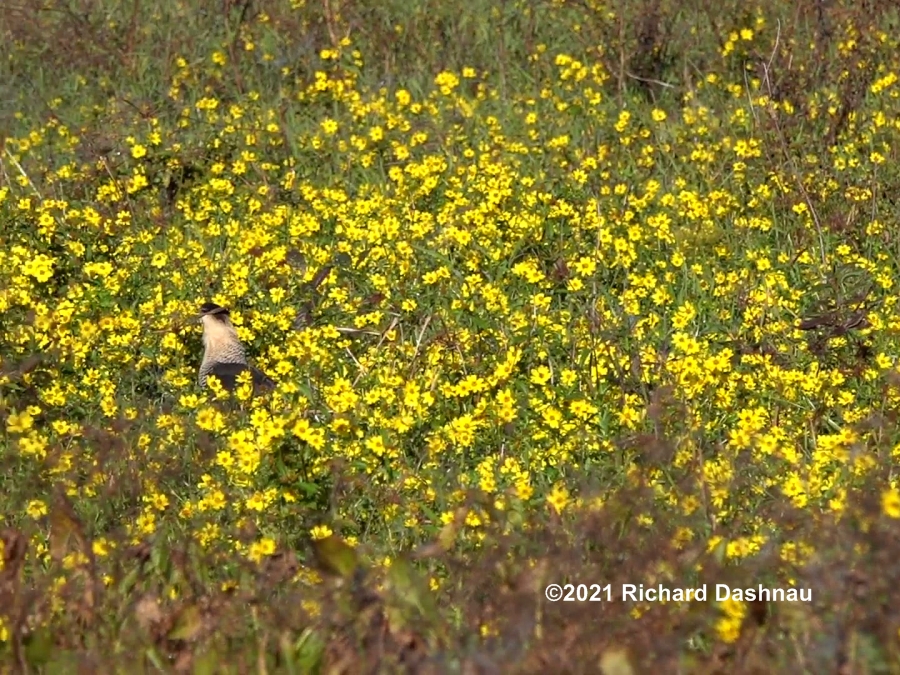
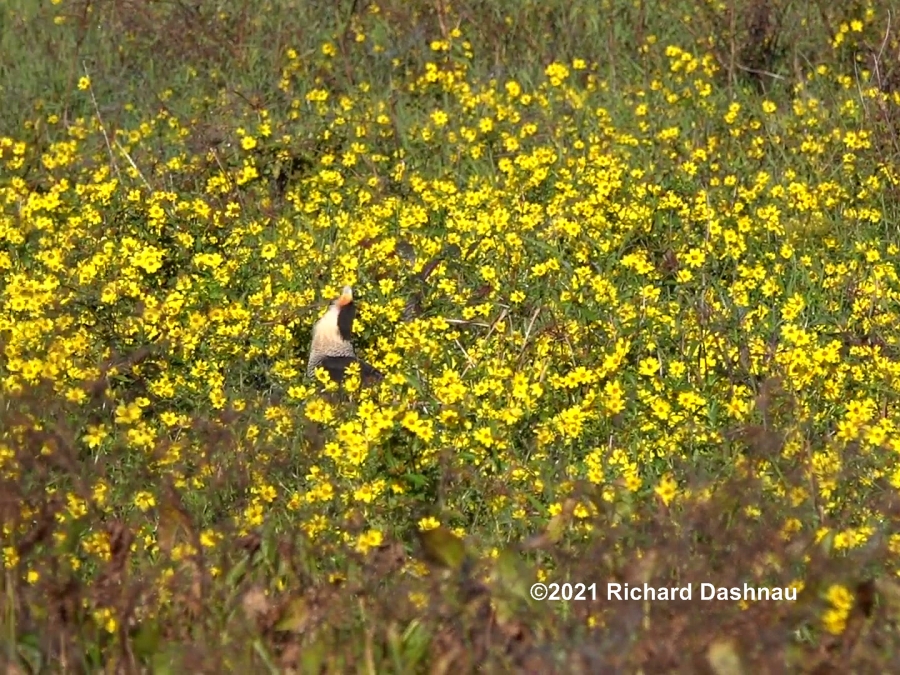
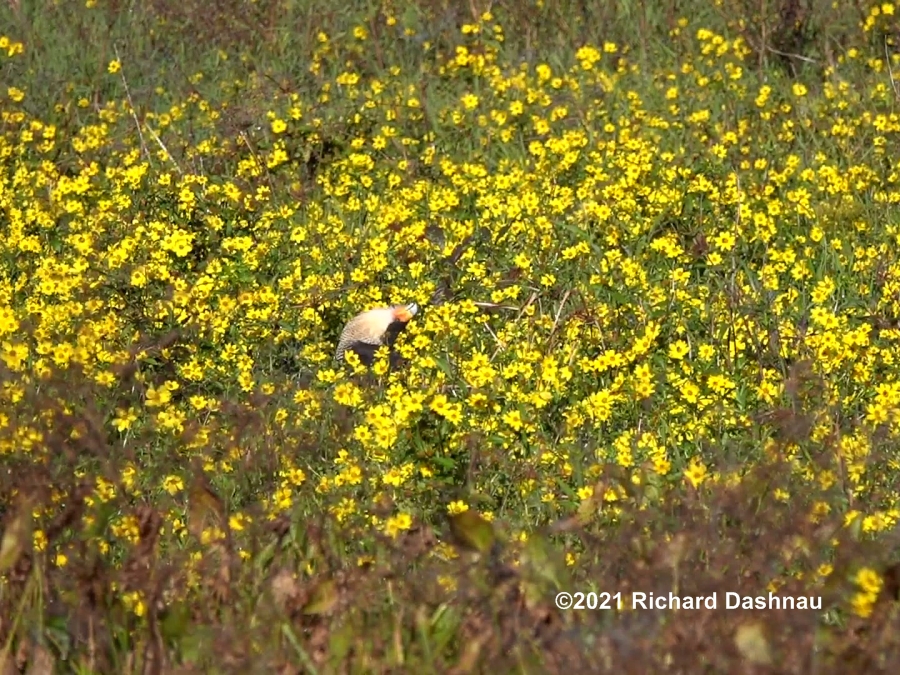
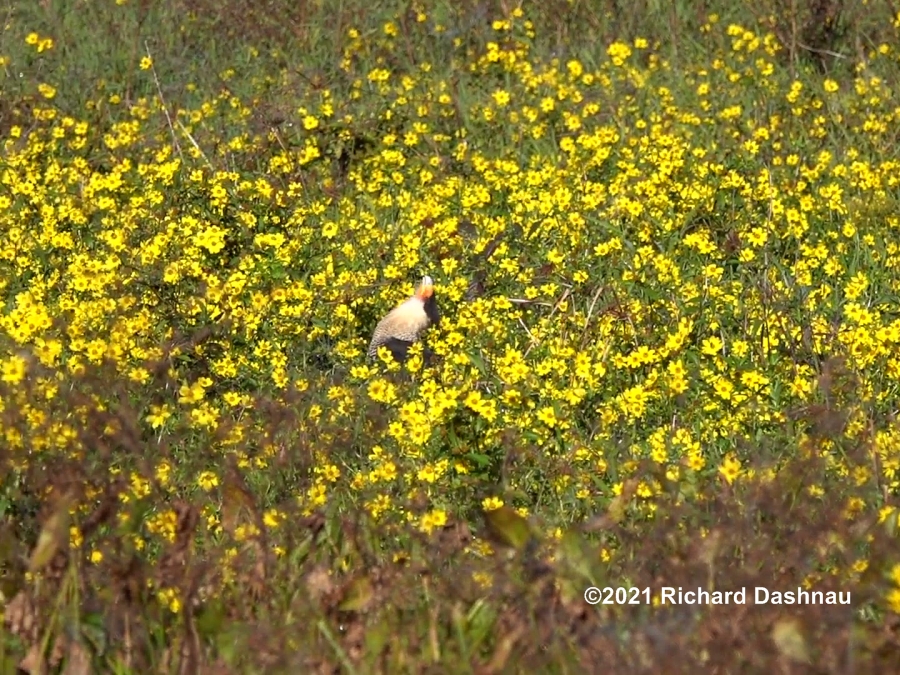
The hawk took off and buzzed
the Caracara again. I don't know where it landed. The Caracara in
the flowers started back to eating. A couple minutes later the
other Caracara came down
to land, but jumped back up out of the flowers. Then the hawk made another swoop at the Caracara. I don't know
where the hawk went after this, but the "flying caracara" ended up
in
the tree where I'd first noticed the hawk. Caracara tried
another landing and took off. Caracara took off, then landed on a
shorter tree. Here's the takeoff sequence.
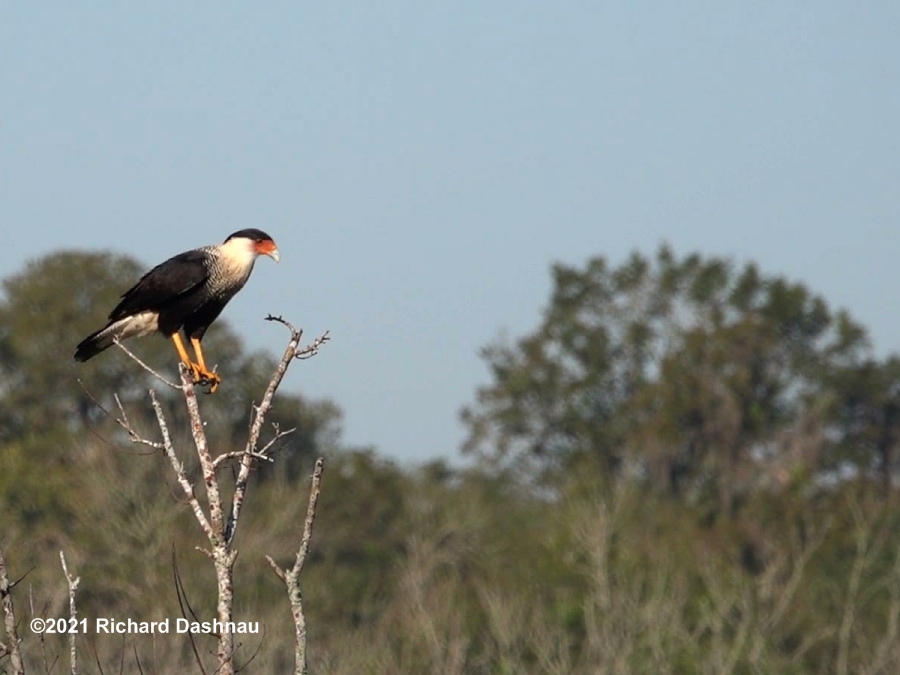
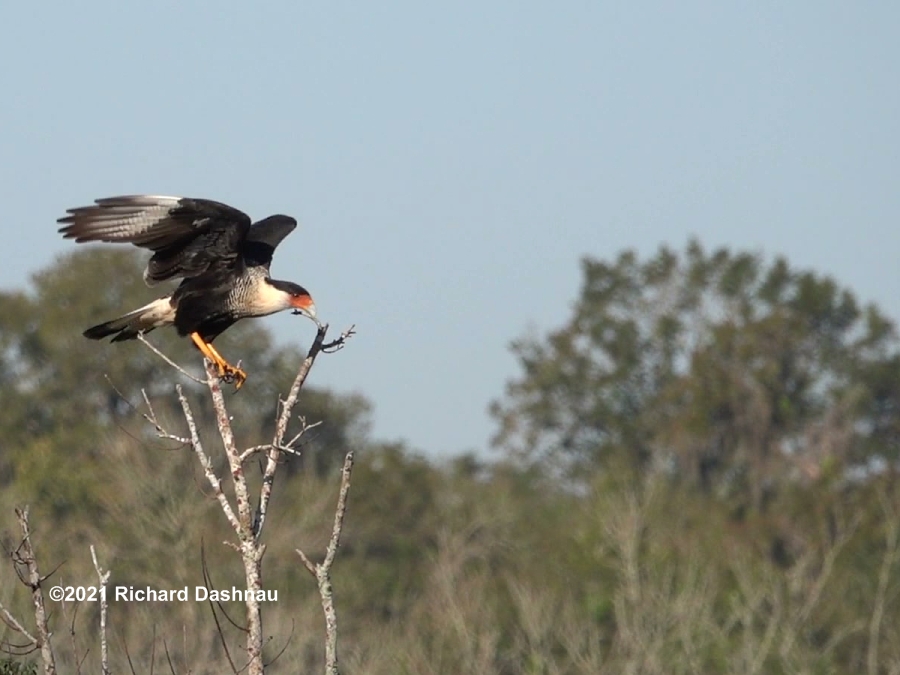
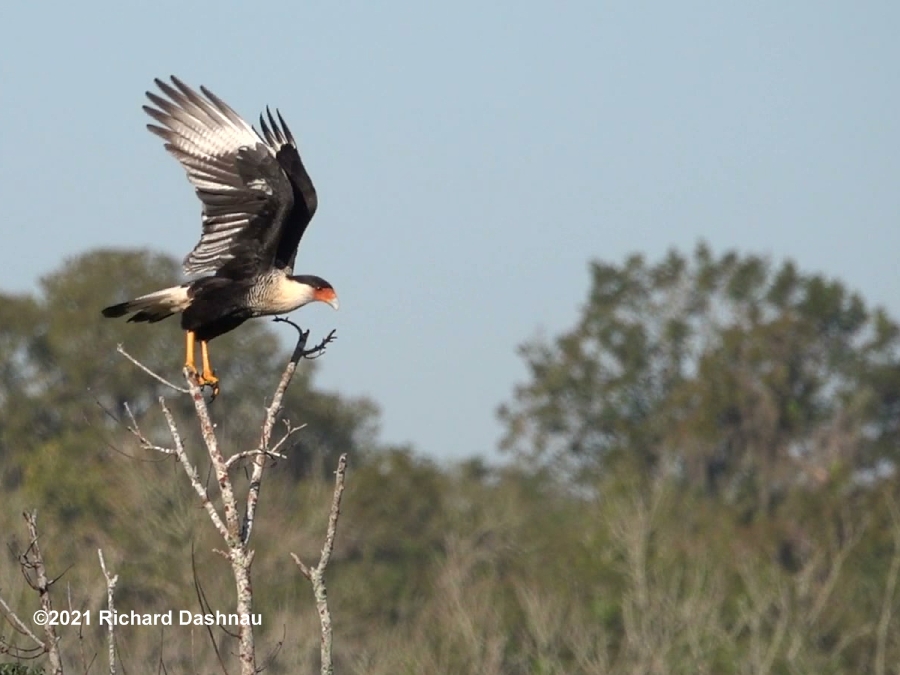
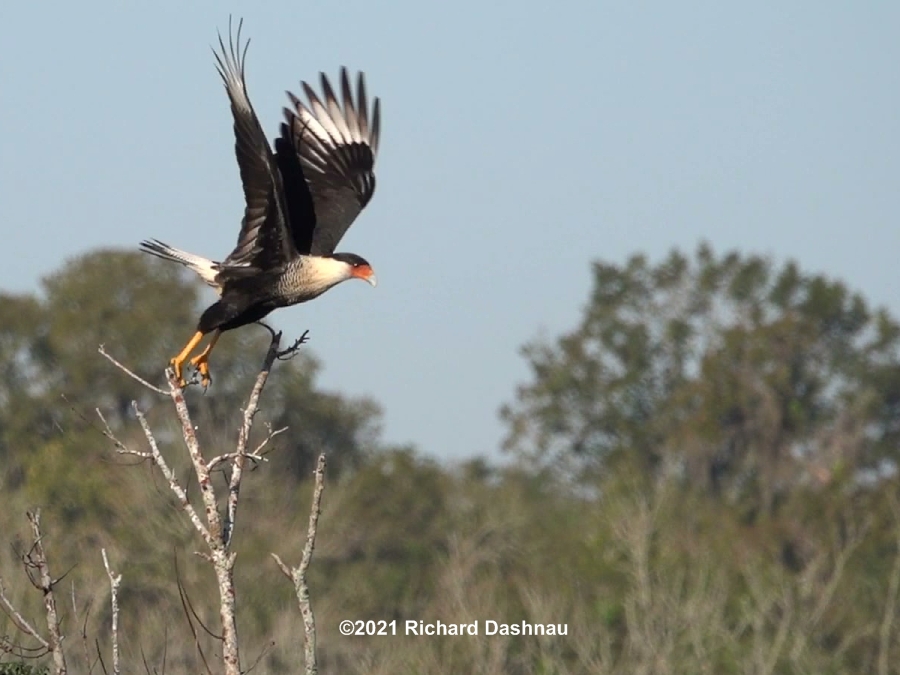
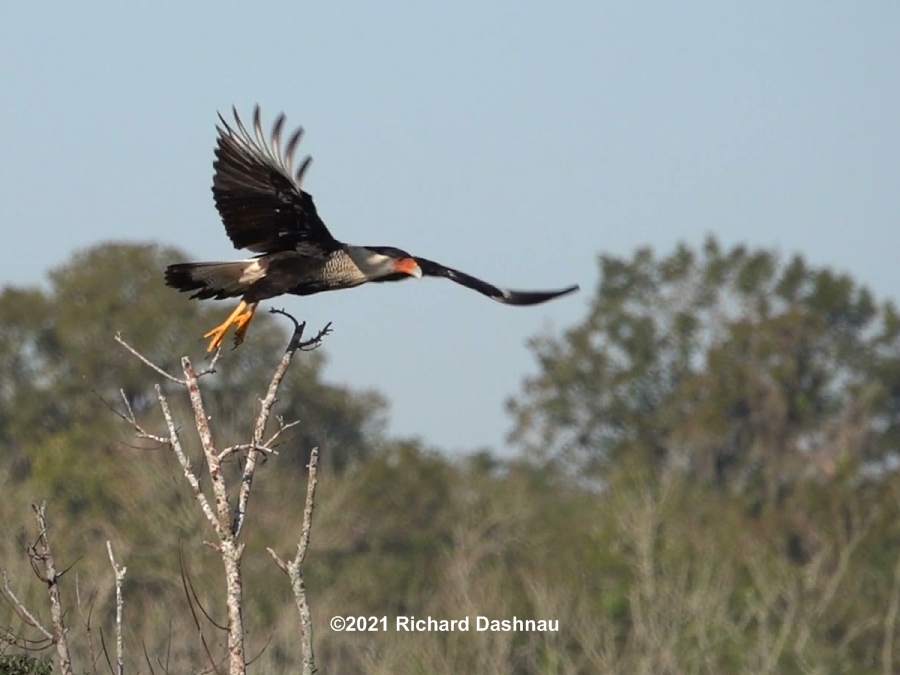
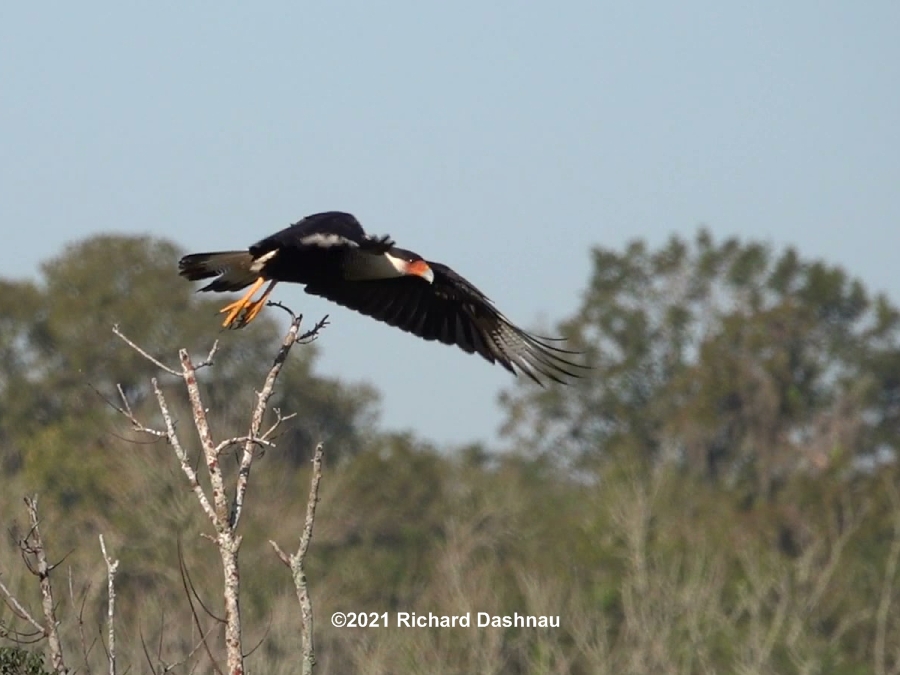
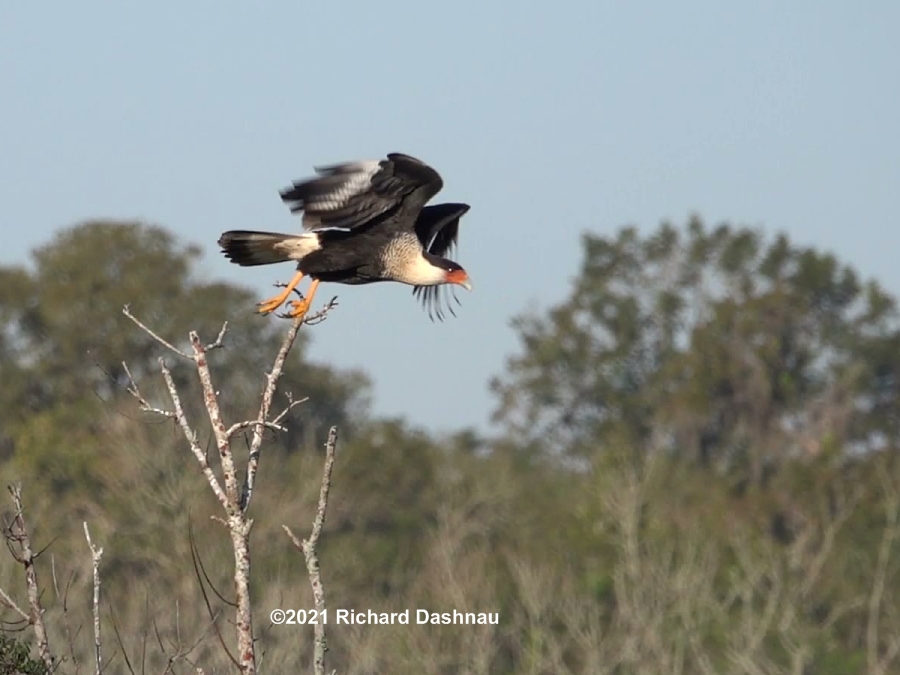
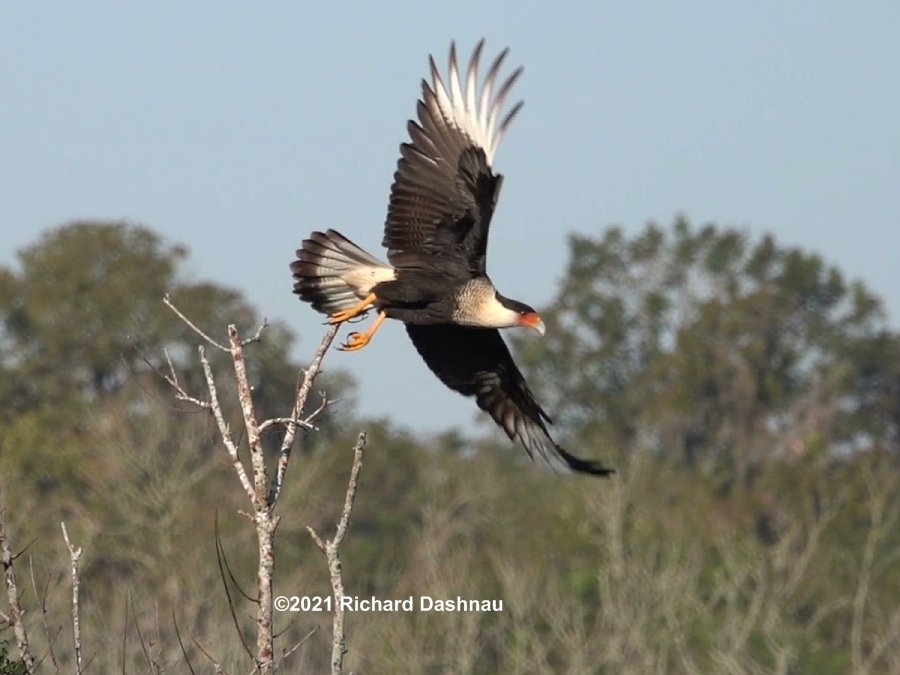
Then that Caracara finally landed in the flowers. The Caracaras
both ate the carcass that was hidden among the flowers. A crow ended up on the "hawks tree".
Caracaras continued eating.
A
crow landed near the Carcaras. One
of the caracaras finally took off. I left soon after. At the
time, I was just observing everything that happened and enjoying the
experience. After
reviewing
the images and video clips, I think I figured out why the Carcaras and
Hawk were so antagonistic towards each other. I believe the Caracaras
had stolen the Hawk's breakfast.
I arrived late to the situation,
but it does explain why the "flying" Caracara was harassing the Hawk
(trying to drive it away)--and why the Hawk was harassing the Caracara
on the ground
(really annoyed by losing its meal and trying to get
it back). Of course, this is just a guess. I know Caracaras
prefer scavenging over hunting; and Hawks hunt often (though they will scavenge).
Again, here's the 7 minute video clip that collects the video I captured of these events.
On 10/31/2021; 8:20am,
there were 2 Crested Caracaras in a tree at the edge Pilant Lake on the
40-Acre Lake trail. One took off, went out, and
looped over the
lake. I got one photo of it flying towards me. But I knew the
Caracara was moving too fast for me. So I started shooting video and
hoped for the best.
Video was shot at 60fps, and playback is not very clear. But, here's a segment of it played back at 1/4 speed. I pulled frames from the video and got some useable images, too.
Recent
genetic studies show C. cheriway (Northern Crested) and C. plancus
(Southern Crested) are the same. So they are all C. plancus now, or
commonly, Crested Caracaras.
For those "birders" who may wish to investigate, here are some links that discuss the current reclassification: link one link two link three
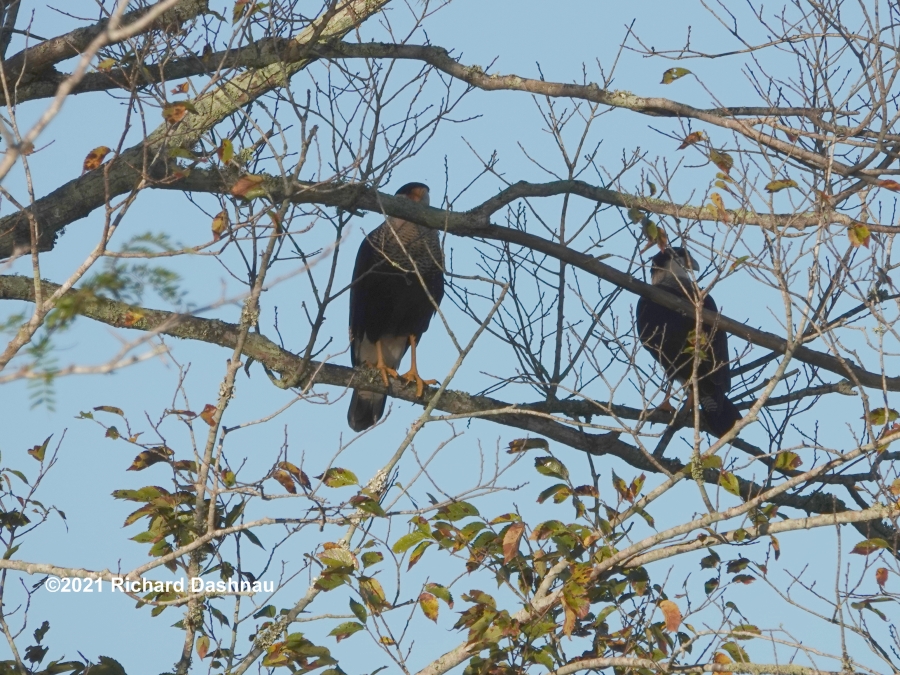
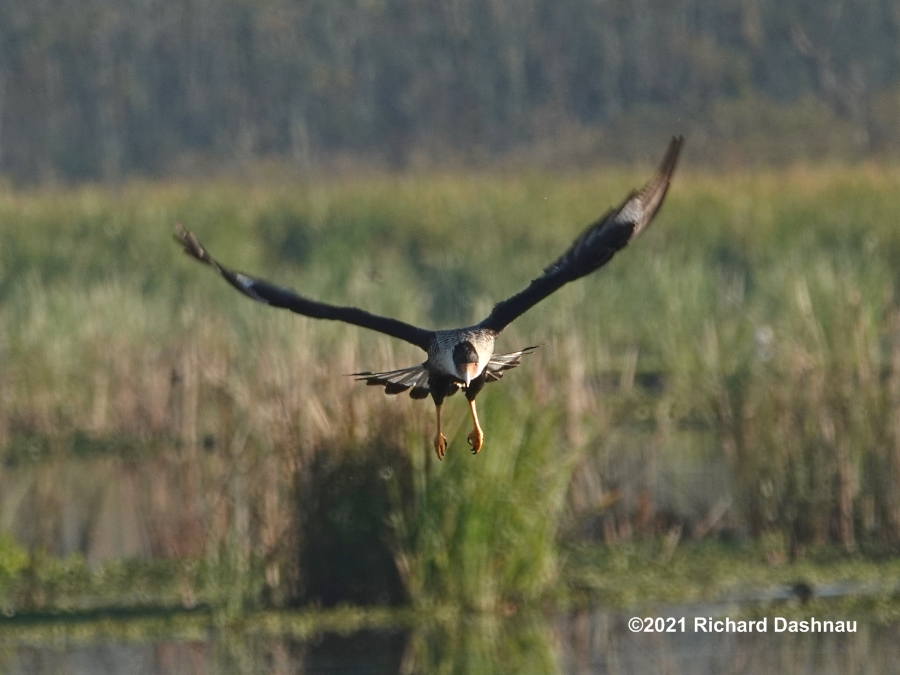
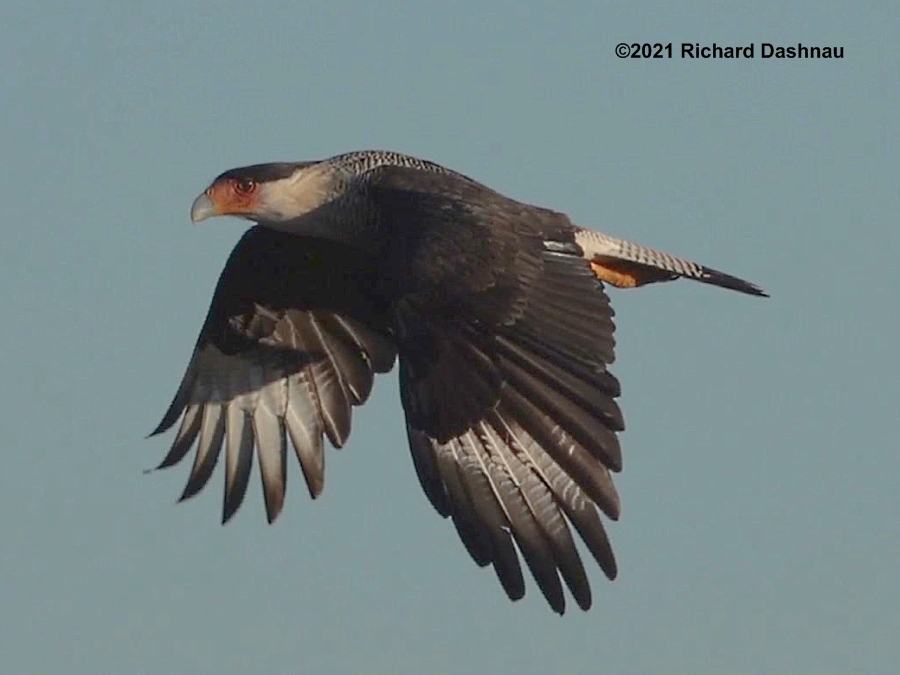
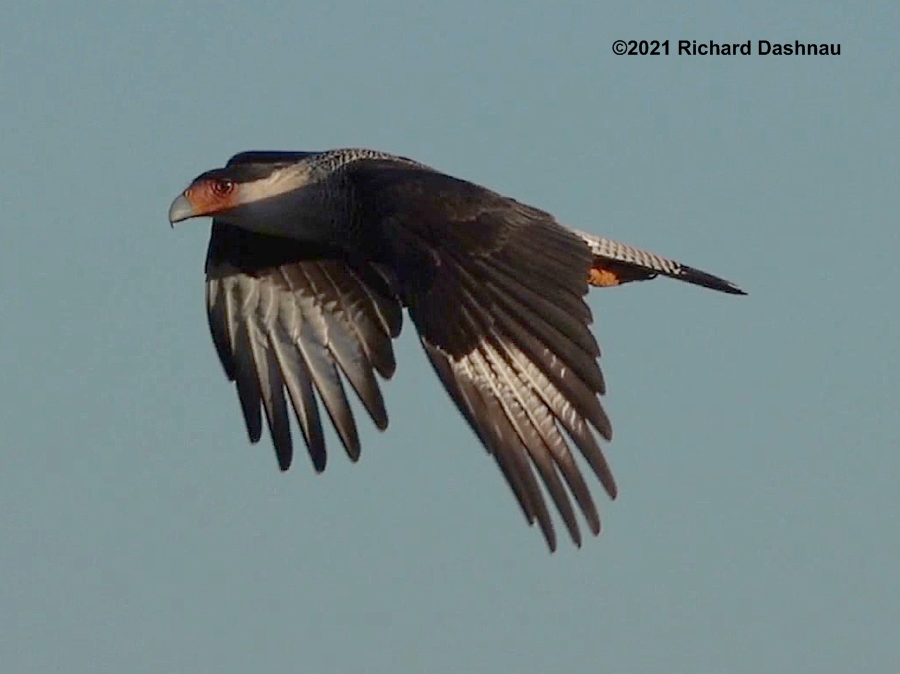
Except for the first two images, these are all frames from the video. These shows how the wings are brought back up and then perform the next down stroke.
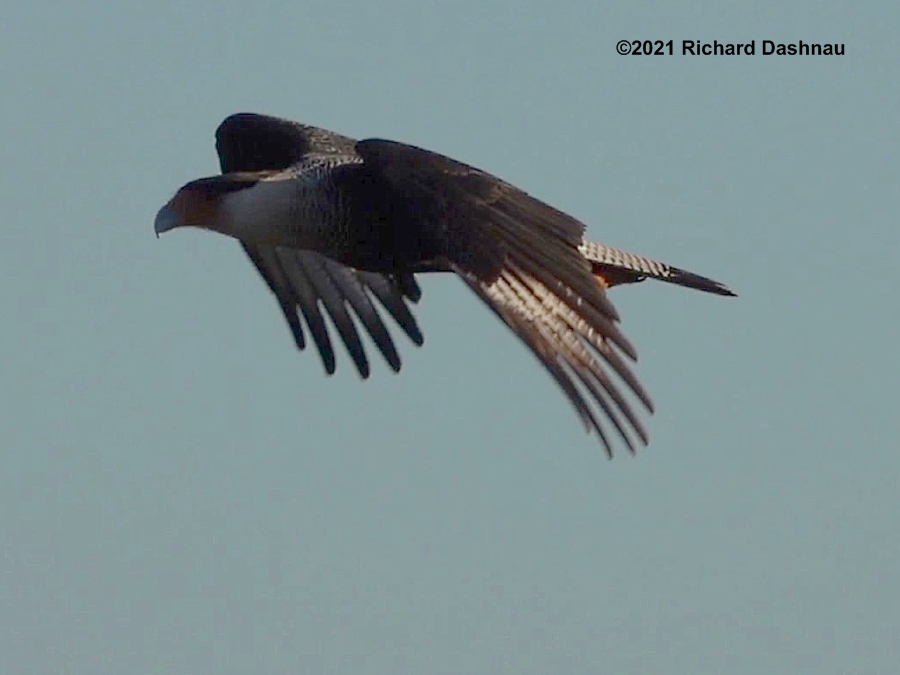
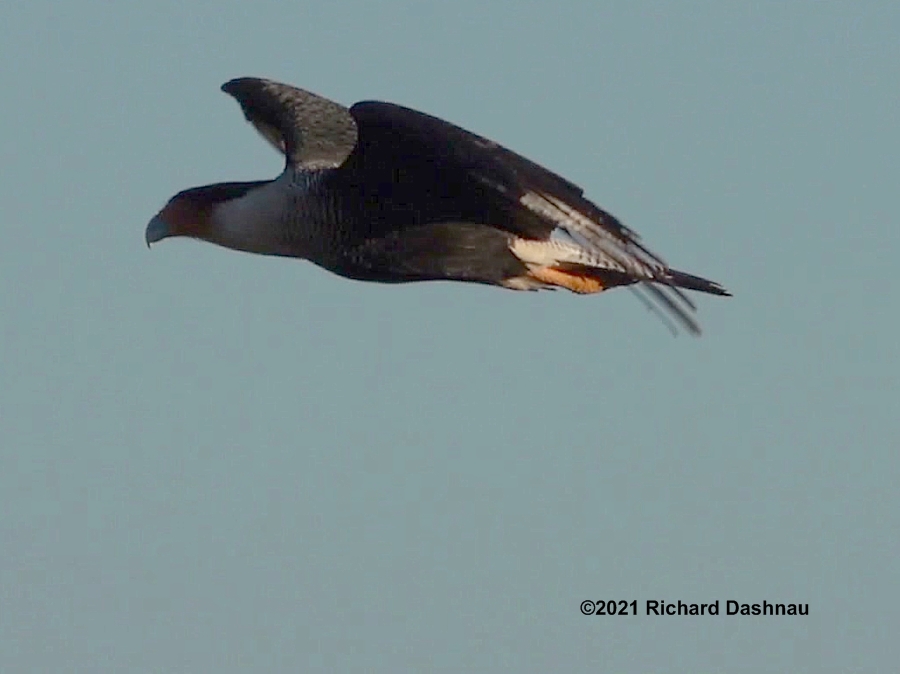
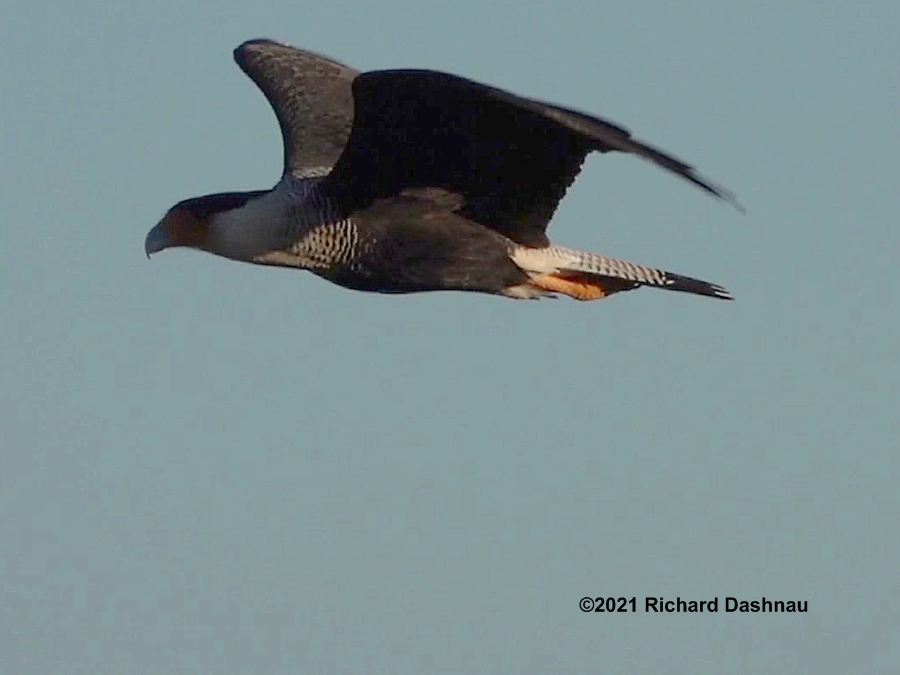
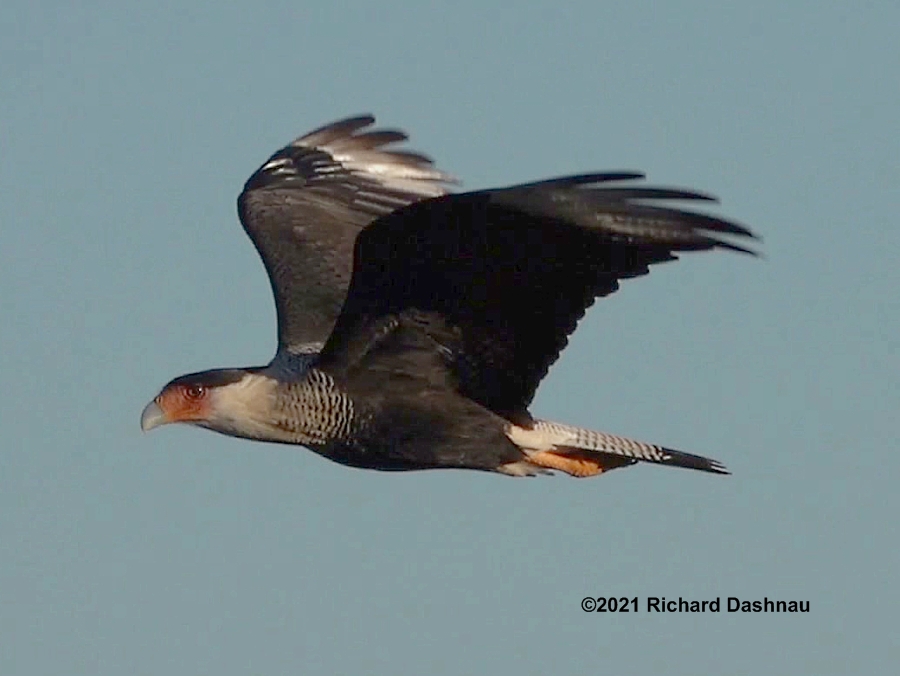
The
wings fold partially to allow for less resistance while being lifted,
then they are extended for increased wing surface on the downstroke.
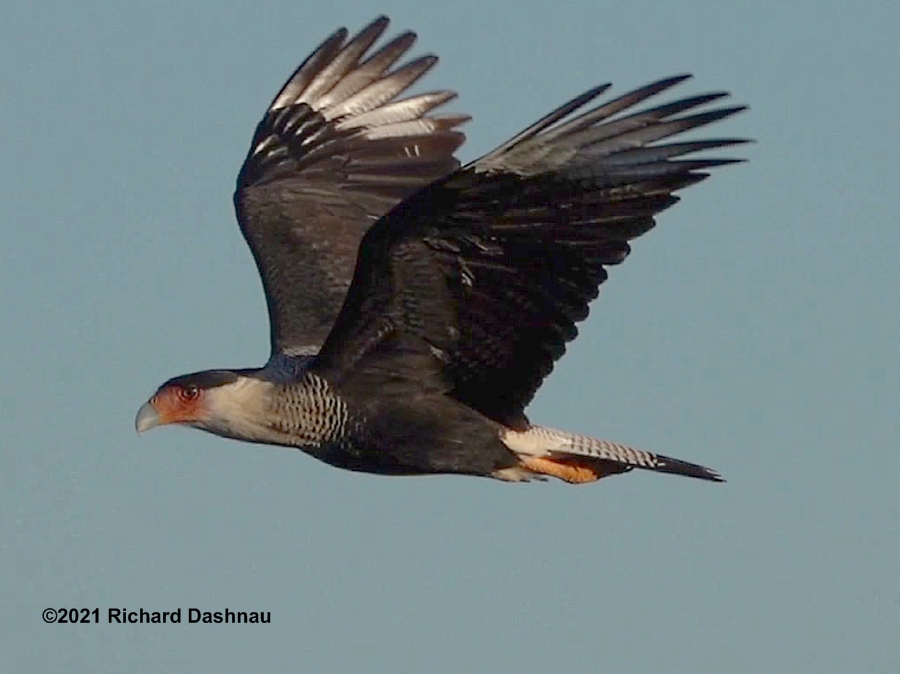
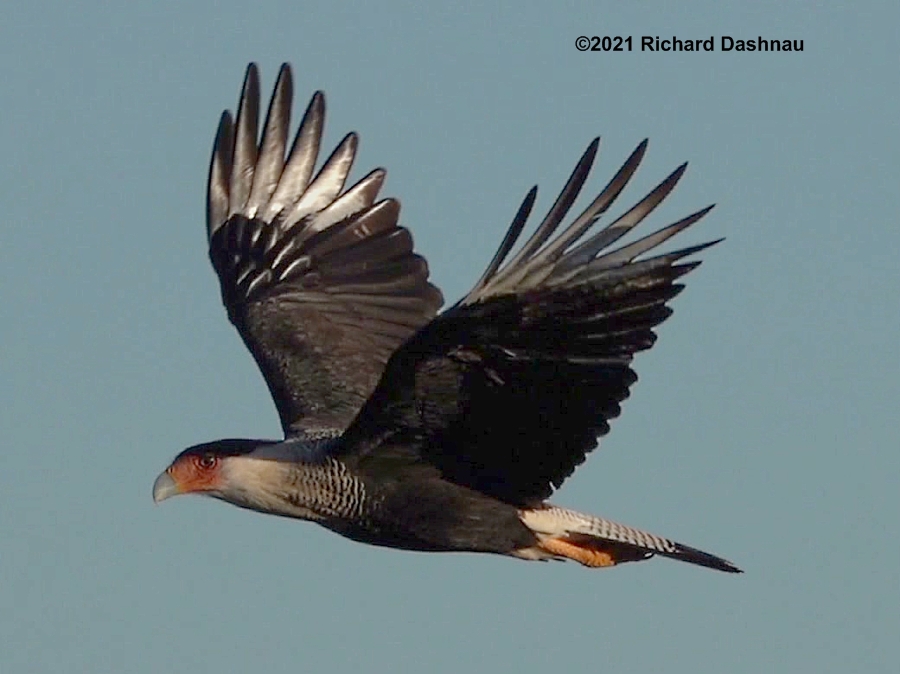
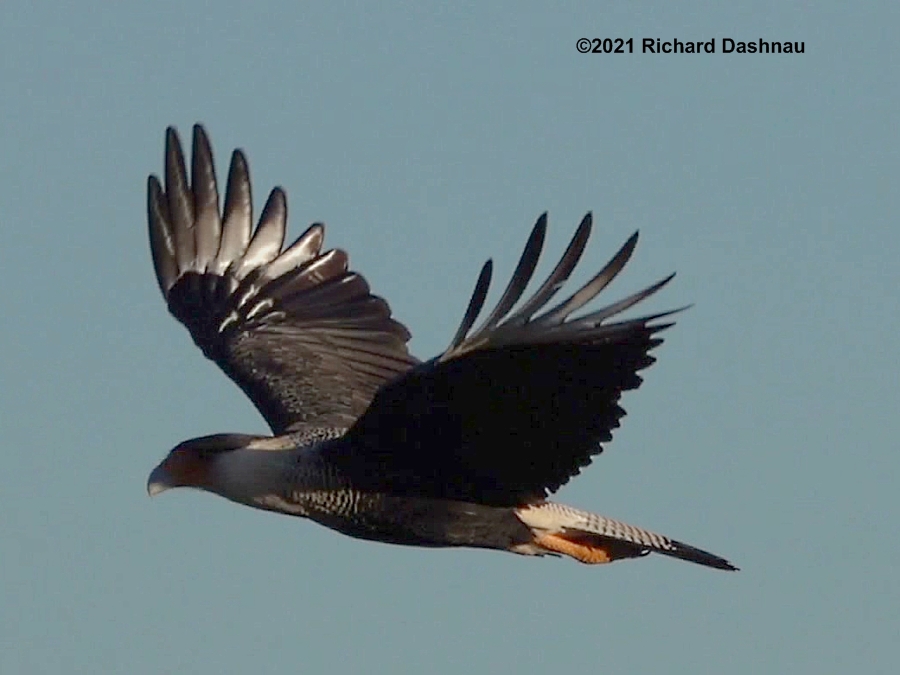
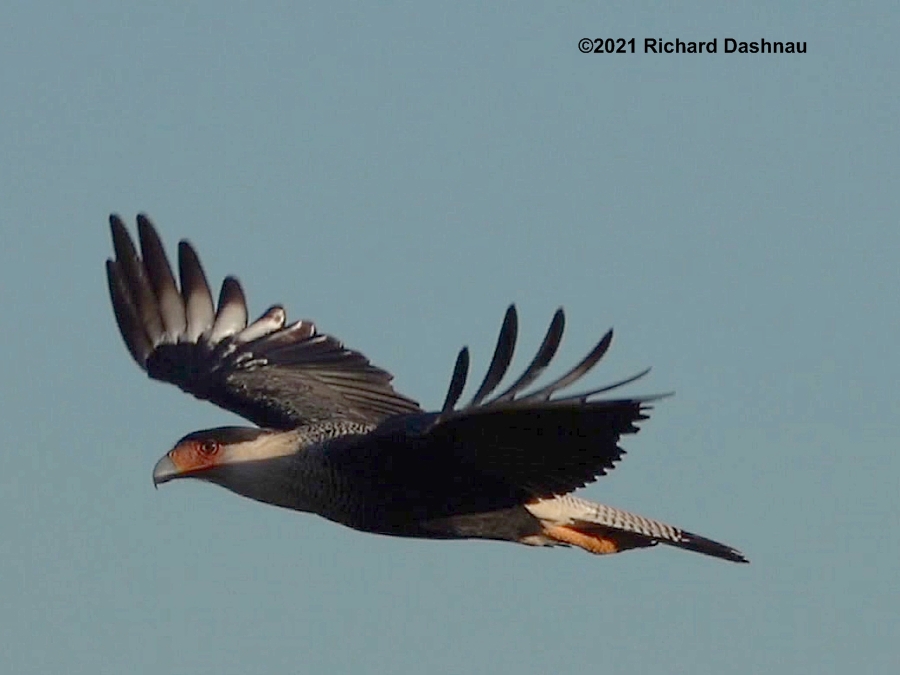
I
consider myself very lucky to live in an area where Crested Carcaras
forage and fly. They are wonderful! Many years ago (2007 - 2010, 2012
), I was also able to visit with Doris Mager and
meet the raptors
she toured with when they appeared at Brazos Bend State Park. I
did this more than once, and my biggest thrill was being able to hold Cara--one of the raptors that
toured with her.
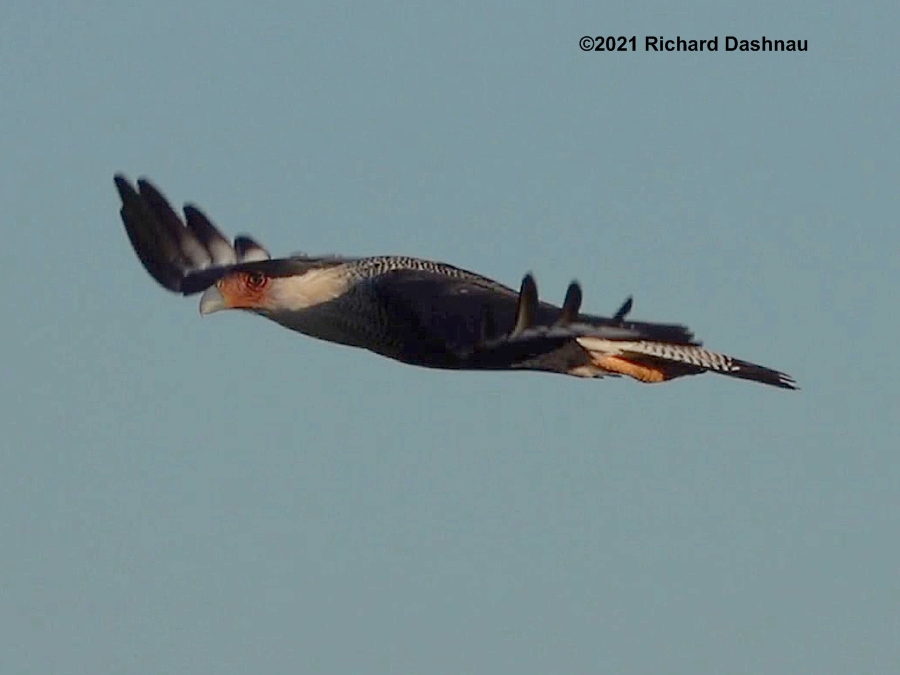
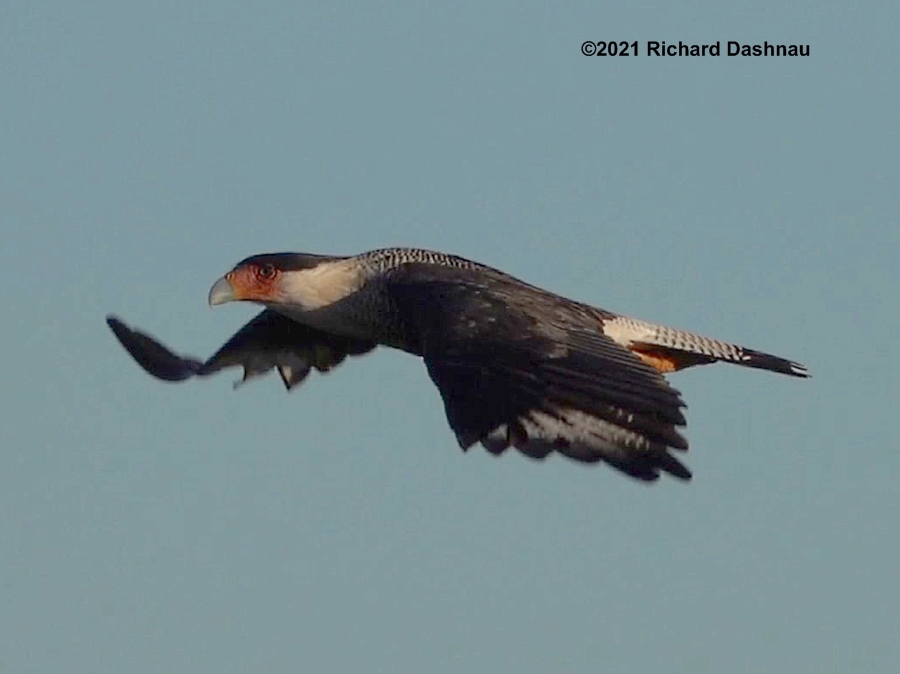
Since
then, I've seen them around. However, I don't usually see them foraging
inside BBSP. I've seen them fly by, or occasionally perch in trees
(like they did this morning). I usually see them
along the roads,
or in fields I pass on the way to the park. Over the last 5 years or
so, I've found some areas near me that Caracaras like to
visit-especially Archbishop Fiorenza Park North.
One one eventful
day out there, I was able to watch (and get video-all from far away) of
a Caracara pushing Turkey Vultures (Cathartes aura) and Black Vultures
(Coragyps atratus) away from
a carcass. 15-minute video is here.
Not
too long ago, I read a book about Caracaras. Although it was inspired
by Striated Caracaras, it does discuss the entire group. It was a
great book! If the reader is interested, it is:
A Most Remarkable Creature by Jonathen Meiburg. Here's a link to his website, so I don't favor any particular seller. There is discussion within of how Caracaras are related to other
birds.
Generally Caracaras are grouped with Falcons and are separate from most
groups of "raptors". Falcons nearest genetic relatives
are...Parrots! I found the genetic studies that he referenced
(thanks to notes in the book). They are interesting, but quite technical for me. On a very related note, Sean McCann is a biologist/photographer that I've been following for some years online.
I'd
seen his research on wasp behavior, and also on Red-Throated Caracaras
(they dive-bomb wasp nests to knock them out of trees). What I
did NOT expect was to see him appear in the book.
And now, I've just
revisited his domain, and have found pictures taken during the
expedition described by Mr. Meiburg in his book. So--read the
book, and look at images (some of which are
in the book) here.
12/24/2018
I went out to Fiorenza park as I often do. I was hoping to see a Bald
Eagle, but of course many other birds show up there. I was on the East elevated
section--near the bridge to the
West elevated section when I noticed
large black birds on the grass about 100 yards away. When I looked
through binoculars, I saw Vultures...but I also so a bird with a
white head. But, it wasn't
a Bald Eagle--it was a Crested Caracara.
Since they were clustered around something on the grass, I assumed
that they had found something to eat...such as a carcass. I'd read that
Caracaras
competed with Vultures for carrion and I thought this was
a chance to watch them together. So, I hurried down the hill, across
the bridge, and back up the hill to where I could see the Vultures.
Then I started shooting video.
I
only watched the birds for about 15 minutes--but a lot happened during
that time. I watched the Caracara (Caracara cheriway) as it chased a
group of Turkey Vultures (Cathartes aura) AND a group
of Black
Vultures (Coragyps atratus) away from the carcass. I couldn't tell
what the carcass had been. I also watched as the Vultures tried various non-violent ploys to get some of that carrion.
I
shoot my "normal" video at 60fps, and 1920 x 1080 resolution.
This allows me to easily slow the video to 30 fps (1/2 speed) and
keep smooth video playback. And, I can crop the video to enhance
details I want to show. From my video clips, I've put
together a video that just under 15 minutes long. The three images below--and today's RICKUBISCAM picture--are frame grabs from the video
clips. the video is linked here. I had a wonderful time watching these majestic birds!!
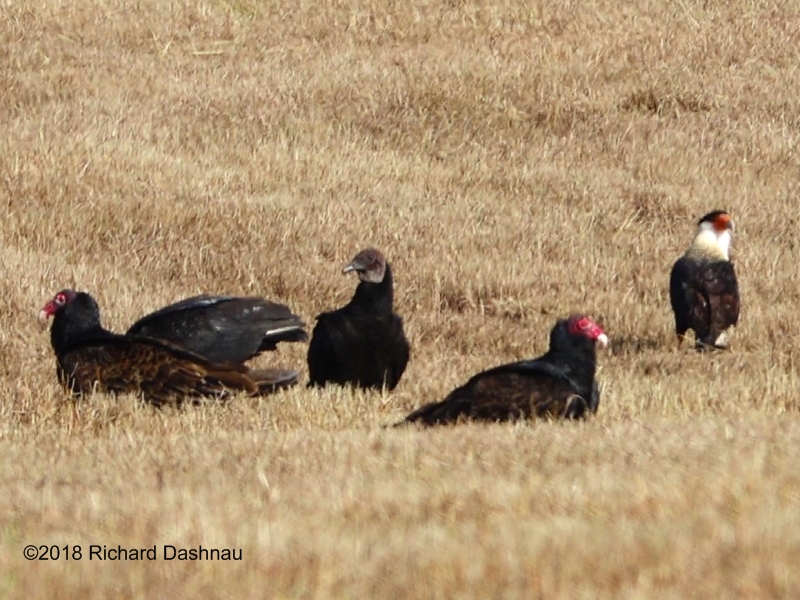
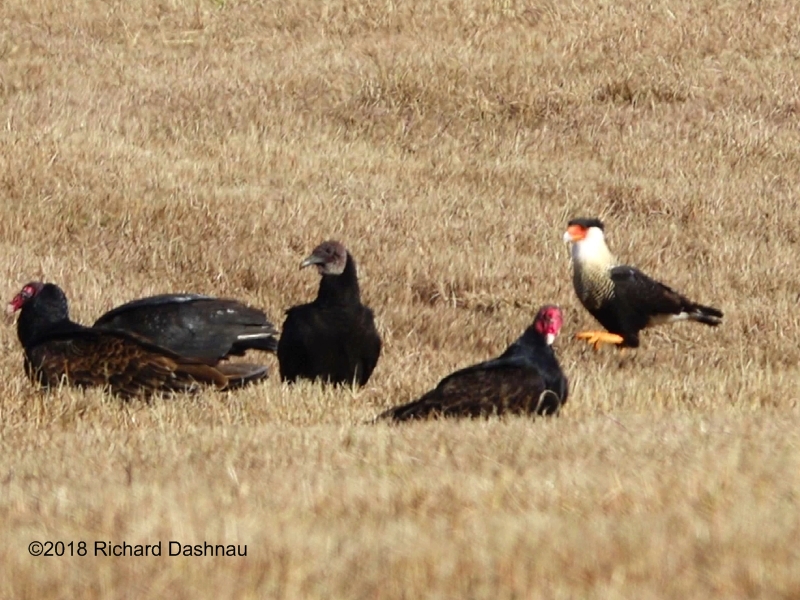
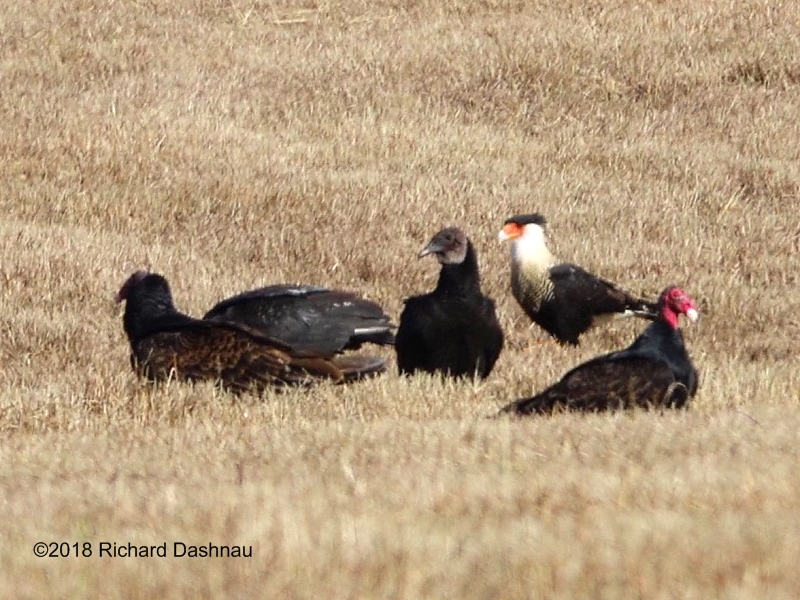
February 11-12, 2012--Doris Mager!! Doris
Mager, founder of S.O.A.R. (Save Our American Raptors) was out at
Brazos Bend State Park again. I try to attend her program at least once
every time she
comes by. This time, I sat in for 3 of them. One on
Saturday (I wasn't working) and two on Sunday. They were held in the
Dining Hall. One of the visitors at the park Saturday emailed me some
pictures and
a video clip. The pictures show below, and the video clip
is here (3.8 mb wmv) or here (4.3 mb flv).
In the clip, I walk to the end of the aisle, then release E.T.
the Great Horned Owl to fly to the front. Doris
has been working
with Eagles and raptors for over 30 years, and has all kinds of
interesting stories and facts to share. It is due to the efforts of
people like Doris that we can go out and see wild Bald Eagles
fly over
our heads (if we are lucky enough to be at the right place at the right
time). But, there was a time not that long ago that everyone thought
all of our Eagles would be gone. I'm always happy to see
Doris!
The fifth picture below shows Doris as she is talking about
the Crested Caracara--while holding Cara the Caracara.
--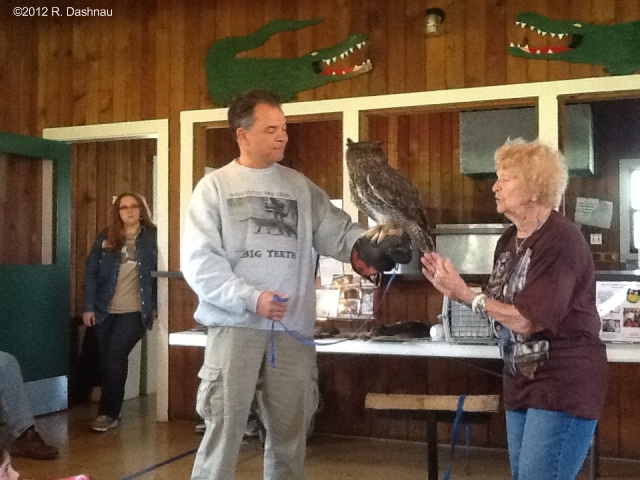 --
--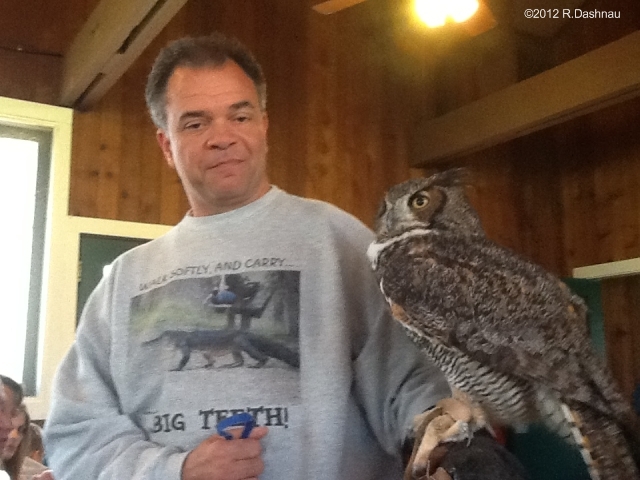 --
--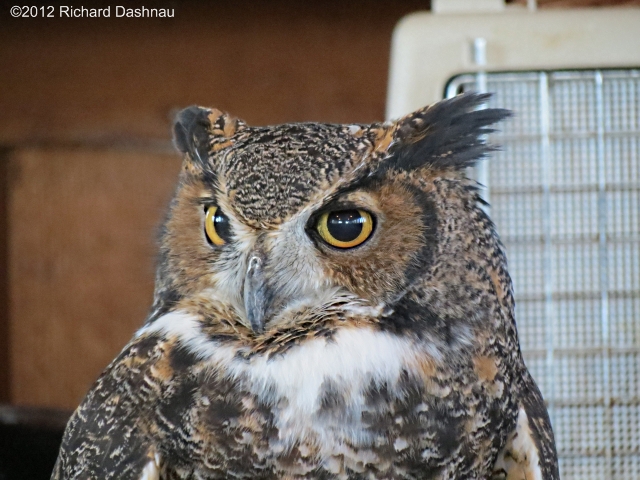 -
-
DORIS GIVES ME E.T.
RICK AND E.T.
E.T WATCHES US.
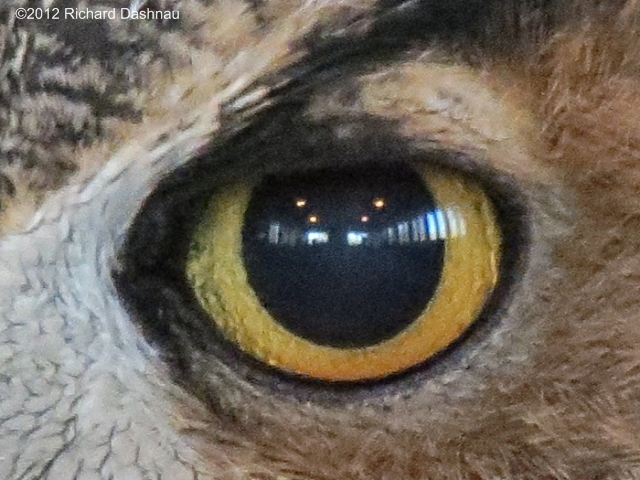 --
--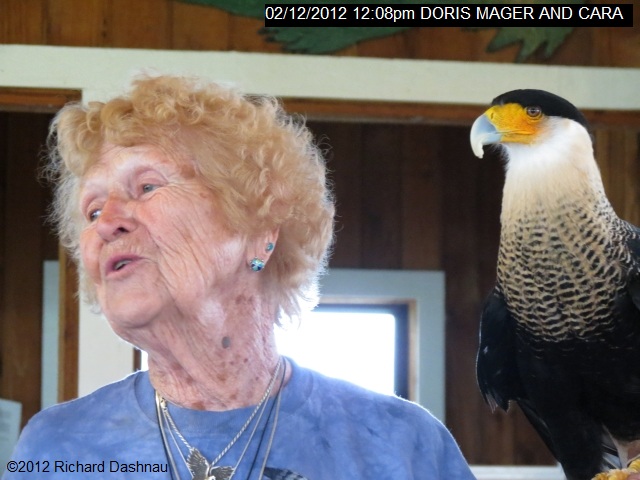
THE DINING HALL IN E.T.'S EYE. DORIS MAGER AND CARA
02/14/2010
BBSP had a visit from Doris Mager of S.O.A.R. (Save Our American Raptors).
Her purpose is to give these programs to expose people first-hand to these
magnificent creatures. It is always a
pleasure and a great thrill to see
her program. It was also great to talk to her again (and I got hugged!).
And, of course, my big thrill was being able to have Cara the Crested Caracara
fly to me. I love that bird!
The programs were held inside this year,
so her birds could fly in safety.
It is
illegal to posses any raptors (or any parts of raptors--including
feathers) without lots of permits and permissions. Doris has these permits
to allow her to have these birds. The birds Doris has cannot ever
be released--for various physiological or behavioral reasons. They have
come into her possession because of misadventures in the birds' lives--from
being stolen from a nest and imprinted, to being injured by
cars or gunfire.
The birds have been with her for years, and have been shown to, and handled
by, hundreds--if not thousands--of people. The birds would not be demonstrated
in the manner that they are if they
were in danger of harm, or if there
was great risk to anyone. So, keep that in mind when watching any
of her programs, or looking at my videos and photos.
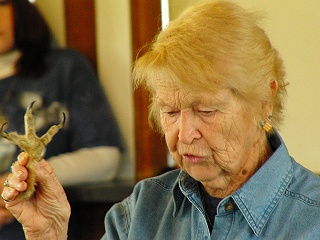 -----
-----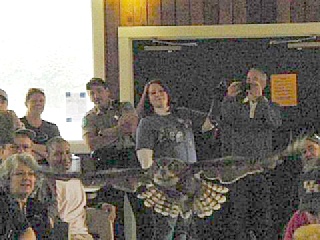 --
--
DORIS
MAGER
E.T. FLIES IN THE DINING HALL! video
clip shot at high speed (wmv 3.0 mb)
Above
left, Doris Mager talking about talons. During the program, E.T. the Great
Horned Owl flew to his perch. I shot this video from inside the kitchen.
The lighting in the Dining Hall is really difficult, with electric
lights
and brightness coming from the windows. So, I had to do what I could with
it. Here it is, shot at 210 fps. Although the Owl flying is wonderful,
the expressions of wonder in the audience are great, too! The
second image
above is a frame from the video.
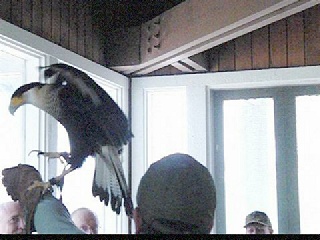 -----
-----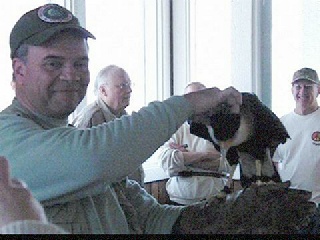 ------
------ 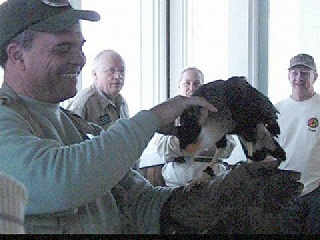
CARA
LANDS ON MY
ARM
TURNING TOWARDS THE
CAMERA
SCRATCHING CARA'S HEAD
video
clip shot at high speed (wmv 18.5 mb)
The
images above are from another video shot with my camera, after I set it
up and gave it to David. (Thanks David!)
Cara
flew a bit prematurely (I hadn't called her yet). She flew a bit high,
and I figured she needed a destination fast--so I called her as she flew,
slapped the gauntlet, and raised my arm. I knew the arm was not
horizontal,
but I wanted her attention. When she landed, I quickly adjusted the position
of my arm *with* her weight when she landed, and---well, the video shows
that it worked. I called her as I had learned, and
raised my arm. It is
supposed to be held horizontal, but I raised it higher, and called her
attention to it. She landed on it, and I was able to shift body and arm
position to keep her weight and balance stable. Her
smooth turn along with
mine in the video shows this. It all happened in seconds. I know
she likes her head being scratched. Even so, in the video you can see how
I paused
slightly (longer in slow motion (00:49))
as I brought my free hand towards
her to judge her reaction. When I saw her allow the hand, I scratched
her
head. I turned and realized my arm might block her from view of the audience,
so I moved my hand away.
While I looked to see where the cameras were so
I could turn her to best exposure, I noted her movement from the corner
of my eye, and focused on her again (1:55 -1:59). I noted her presenting
the top of her
head, once again paused to see reaction to my hand (this
time she actually pulled at it with her beak :-)) and I scratched her some
more.
I couldn't
resist. My huge grin came directly from the feeling the brief
communication
with this magnificent bird gave me. After all, she flew to me, and
then she invited me to touch her. Would I do anything like this with a
wild
raptor? Of course not.
02/08/2009--
----------------------
------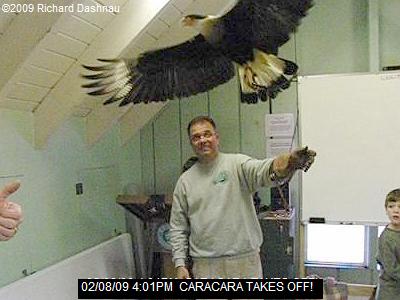
-------------------------
RICKUBISCAM 02/08/09
I had
no luck spotting any Otters. However, we were also visited again by Doris
Mager, the Eagle Lady, that weekend. I sat in on(and helped a little with)
her program. I shot pictures of ET the Great Horned Owl
(ET for Extra
Terrific); and Cara, the Crested Caracara (see the two pictures below).
And, I got to handle the Caracara again! How cool is THAT?! One of the
park volunteers followed my directions, and with my
camera, took some video
footage while I had the bird. (thanks Diane). To see the edited video,
click here
(wmv 11.6 mb). The old RICKUBISCAM shot above is a frame
grab from the video. I've mentioned Doris
before on my pages. To see some
pictures and/or videos of my previous mettings with her traveling companions,
look further down on this page.
Being
able to talke to Doris and being close to the birds helped take
the sting
out of missing the cool Otter sighting.
-------------------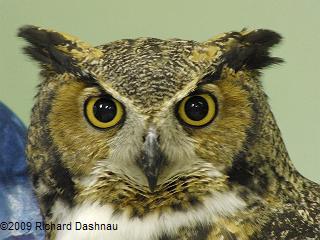 ---------------
---------------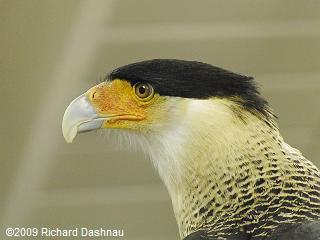
ET the Great Horned
Owl!
Cara the Crested Caracara
02/10/2008
Brazos Bend State Park was lucky to have Doris Mager, creator of S.O.A.R.
(Save Our American
Raptors) return for the
weekend, starting Friday. I was able to attend her last program, at about
4:00pm.
I was also able to help, and once again I got to handle Kara the
Caracara for a while, and then I was able to help a bit with the Great
Horned Owl. I was able to have someone shoot a short video of the Caracara
flying
to me, and then David shot one of me with the Great Horned Owl.
Doris is the one describing E.T. the Owl in the video clip. These birds
are fantastic when I get to see them fly overhead, or in a tree, but there
is
NOTHING like being able to look one in the eyes as it is perched on
your arm! You can look on
my
page here to see images from Doris' visit last year (look for the entry
marked 2/11/2007). It's days like this that make
it really worthwhile
to be a park volunteer!
-------------------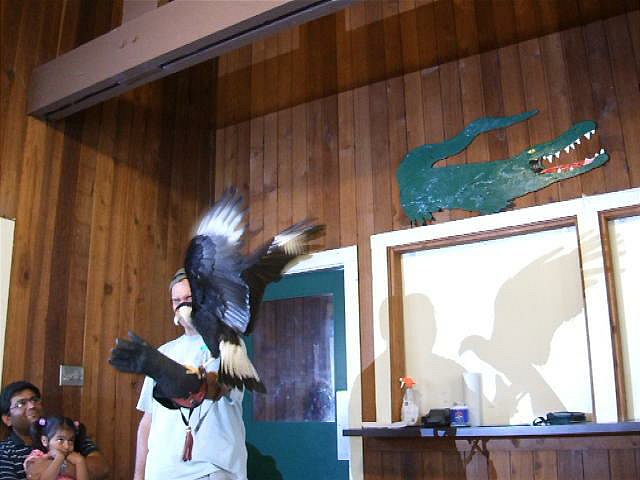 ------------
------------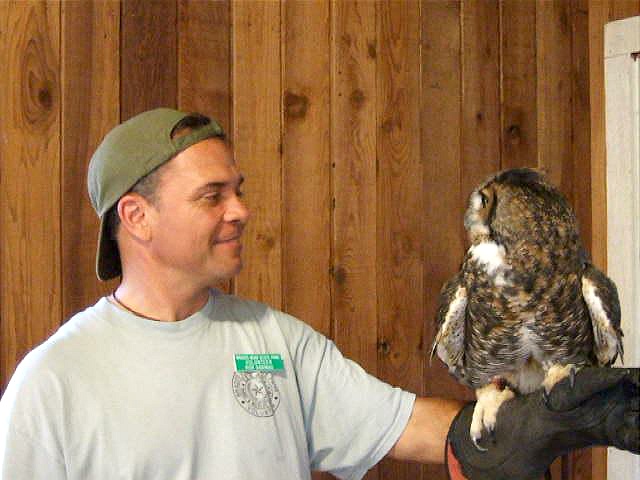
RICK AND CARACARA
02/10/08
RICK AND GREAT HORNED OWL 02/10/08
Rick and Caracara
clip (wmv 1.6 mb)
Rick and Owl clip (wmv
5.9 mb)
02/11/2007---This
weekend BBSP was visited by Doris Mager, founder of S.O.A.R. (Save Our
American Raptors). She brought 3 live raptors with her; a Great Horned
Owl, an American Kestrel, and a Crested Caracara.
The image below right
shows me with the Crested Caracara. Live! On my arm! Ever since I saw my
first wild Caracaras a few years ago, I've wanted to get a closer look
at one, but haven't been able to. I've seen them on
Galveston Island, in
fields on the way to Brazos Bend State Park (BBSP), and even northeast
of Houston.
-------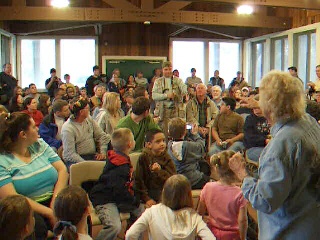 -------
-------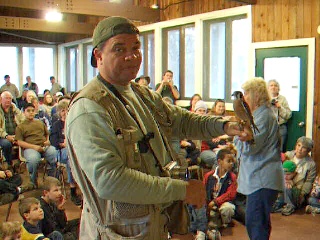 -------
-------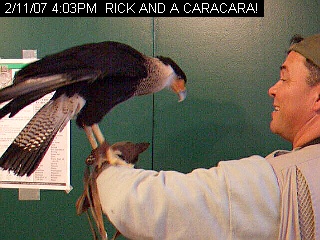
-----
--DORIS IN FRONT, ME IN BACK ---- -------------------
RICK
AND KESTREL------------- ----------------
RICK
AND CARACARA
------------------------------------------------------------------VIDEO
CLIP (3108 KB WMV)
I also
got to "demonstrate" the American Kestrel while Doris talked about it (see
DORIS IN FRONT, and RICK AND KESTREL, above; both images from the video
clip). (By the way, watch the video clip linked above,
and you'll see and
hear Doris.) But, this or the Owl didn't compare, in my eyes, to being
able to be so close to the Caracara. Not only could I see it up close,
but I got to call it to me, and scratch its head. It was SO
COOL!
The images below are frames from a video clip that was shot by Chuck
with my camera. Thanks, Chuck! By the way, we all had our caps backwards
during the program because the Owl didn't like the bills pointed
towards
it.
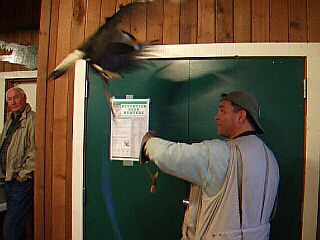 -
-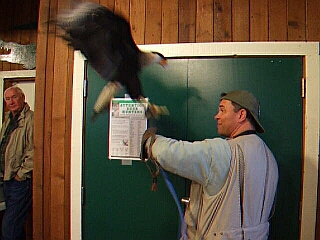 -
-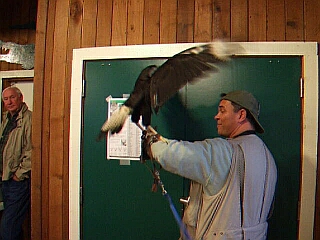
-----VIDEO
CLIP (779 KB WMV)-----VIDEO
CLIP slow motion no sound (2,550 KB WMV)
-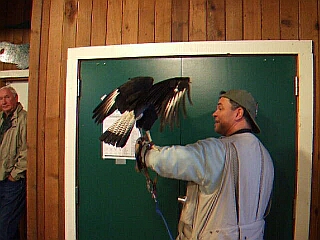 -
-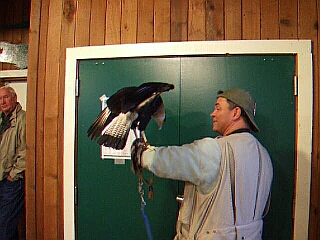 -
-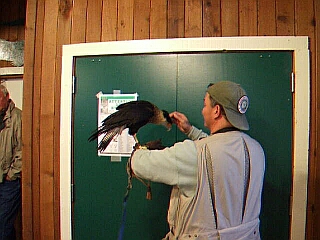
According
to my Sibley's Field Guide to Birds of Eastern North America, on page 112,
the Crested Caracara (Caracara cheriway) is about 23 inches long, has a
wingspan of 49 inches, and weighs 2.2 lb.
It feeds mostly on carrion, but
will take small reptiles and mammals. It searches for food by flying low
early in the day to find carrion before the vultures are flying.
I've seen other articles on the internet that
refer to the Crested Caracara
as "Polyborus plancus", while my copy of The Encyclopedia of North American
Birds calls it "Caracara plancus". This bird is also called the "Mexican
Eagle" and appears on
the flag of Mexico. It was so great for Doris to
pay us a visit! It's very important to remember that these birds
are not able to be released into the wild ever again, because they would
not survive. This was
because of direct human intervention into their lives.
Although their situation is not the best, they can at least be used to
educate people about the problems our mighty raptors have to face.
It would be a
terrible, terrible waste to lose any of these birds.
Doris
is a very unique individual, and at over 80 years old, is quite amazing
in her own right. To see more about Doris, you can go here,
here,
and here.
Doris gave programs Friday, Saturday, and Sunday. I went to the last one
on Sunday, and I'm so glad I did.
June
02, 2003
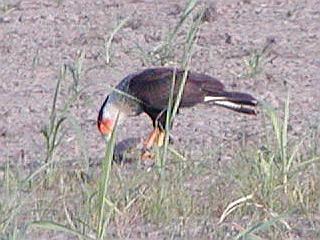 -
-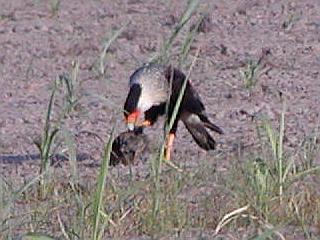 -
-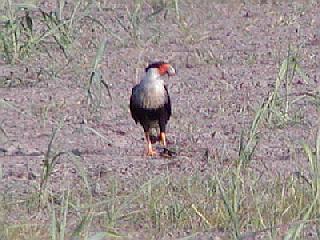
CRESTED CARACARA
WHAT'S IT EATING?
I'M EATING! GET LOST.
On the
way to the park this morning, I saw this Crested Caracara eating in one
of the fields along FM762. Although I'm not a birder, I can't help
but admire the beauty of raptors, and raptor-like birds. Seeing
one
of these fine animals close enough to take *any* kind of picture is a treat.
I'd gone past it, and decided to turn around to get a better look. Since
I remained in the car, so I wouldn't scare it off, I was in an
awkward
position for taking pictures. It appeared to be eating something larger
than a mouse, that appeared stiff on the outside (perhaps a turtle or small
armadillo?). See the three pictures CRESTED
CARACARA, WHAT'S IT EATING?,
and I'M EATING, above. I also have a short video clip (somewhat shaky because
I was in the car and without tripod). Click the link to see it. (cara1.flv
1160 kb),
Brazos
Bend State Park The main page.Brazos
Bend State Park Volunteer's Page The
volunteer's main page.
Go back to my home page, Welcome
to rickubis.com
Go
back to the RICKUBISCAM page.
Go
back to the See the World
page.













































































































